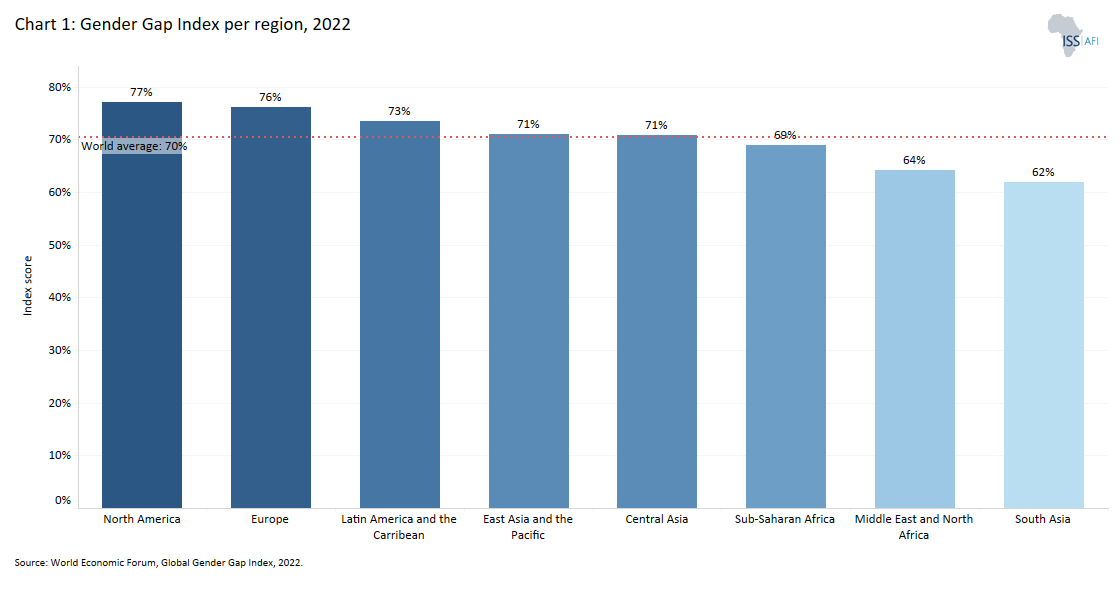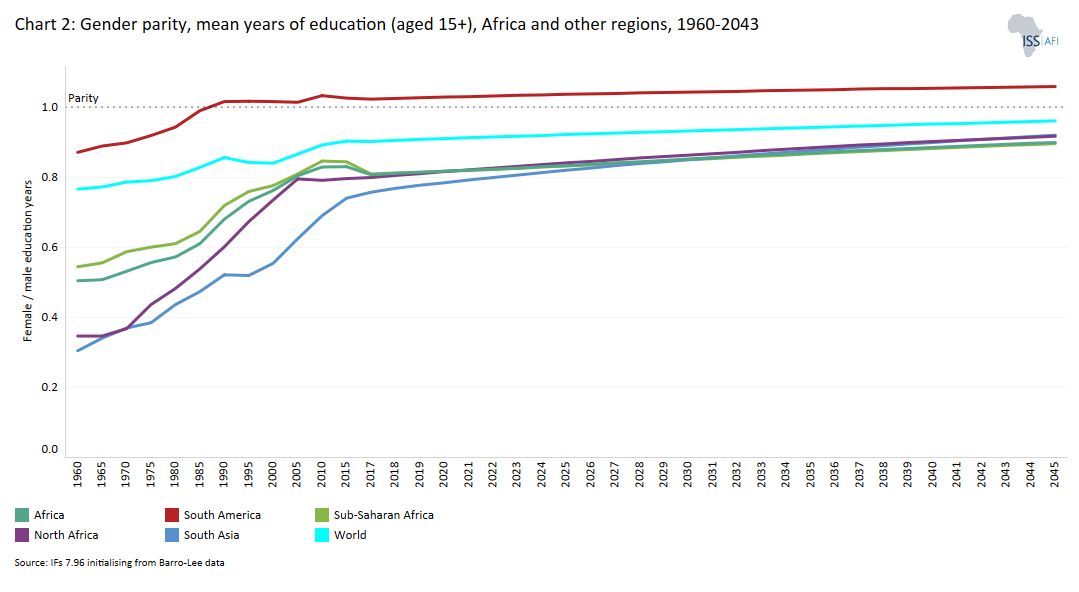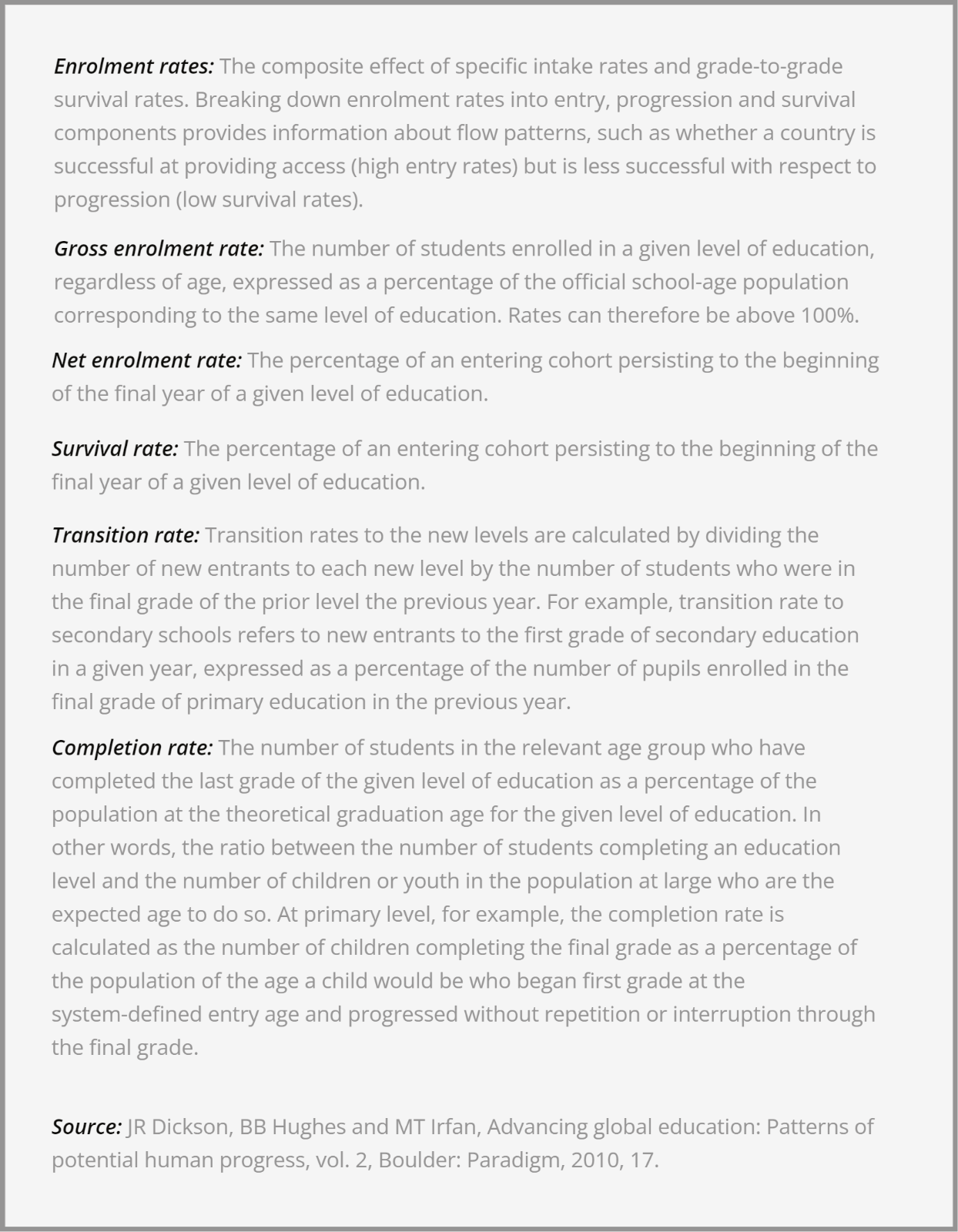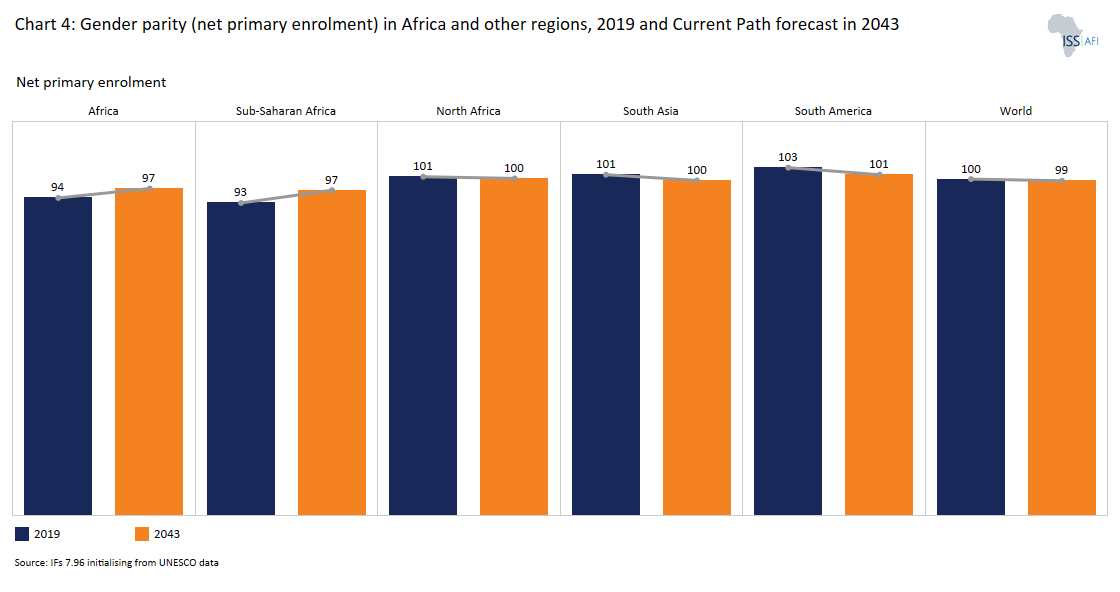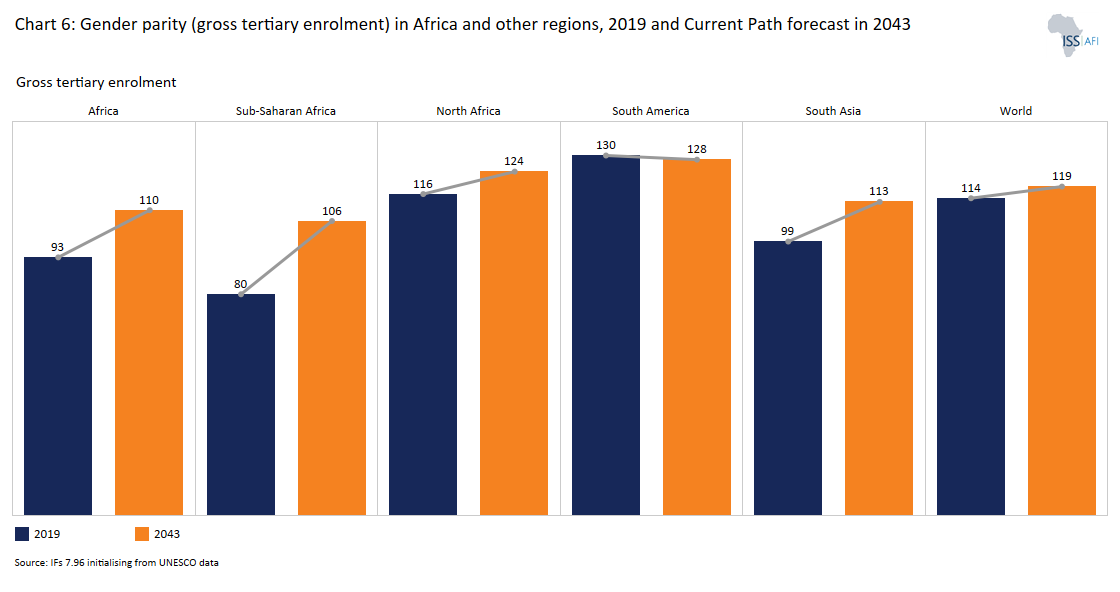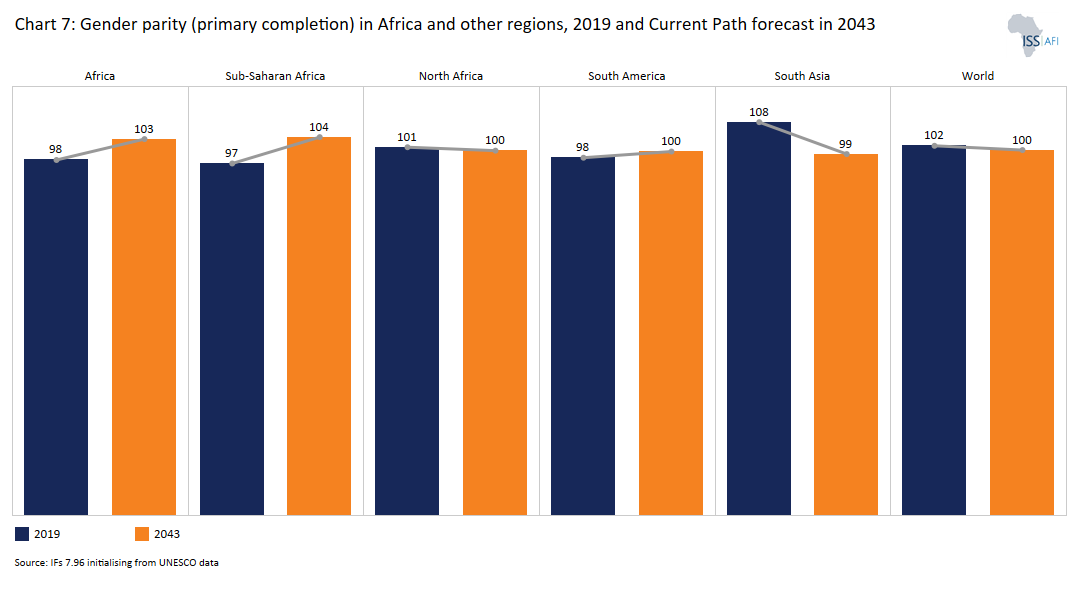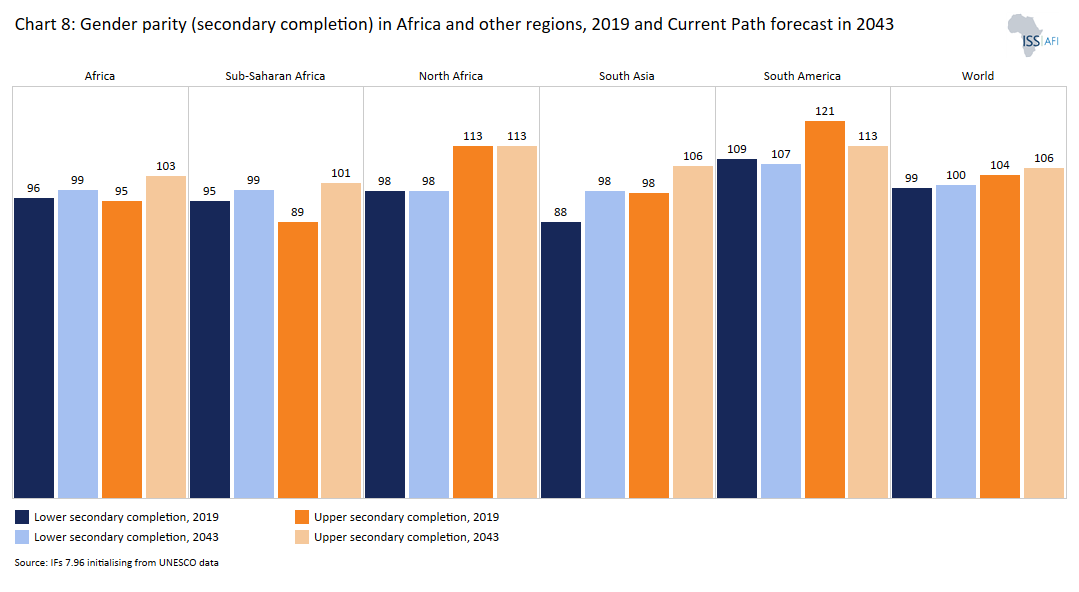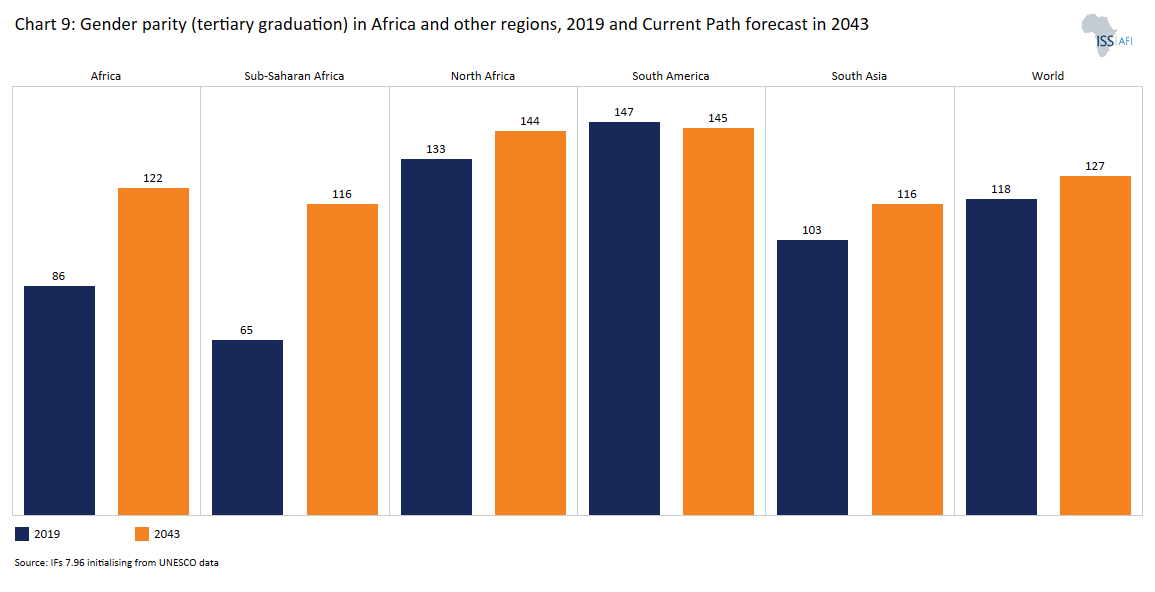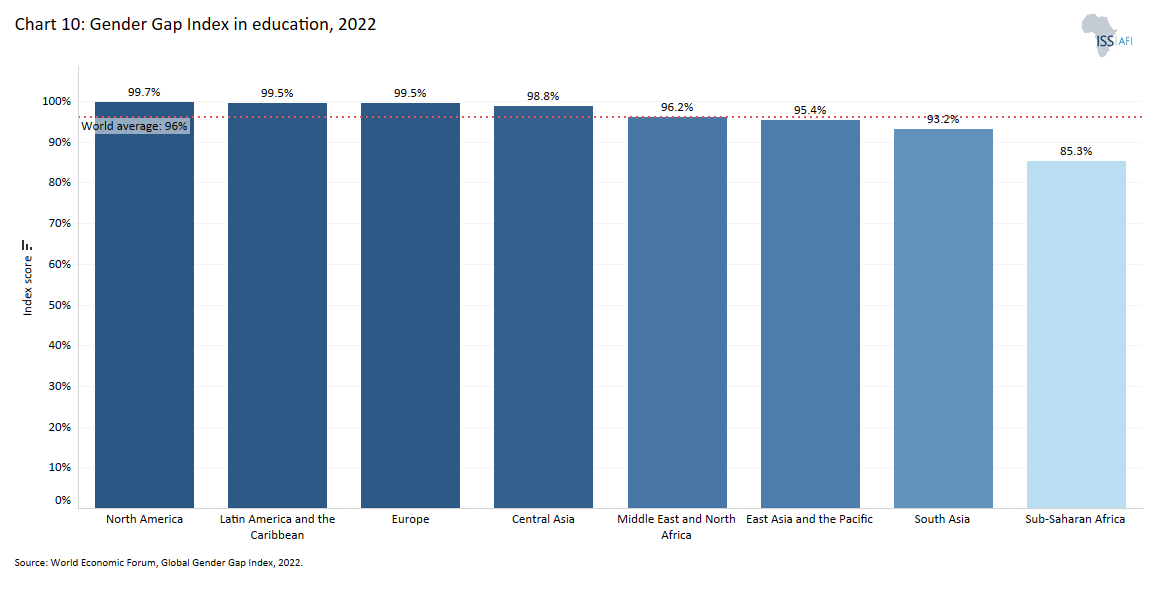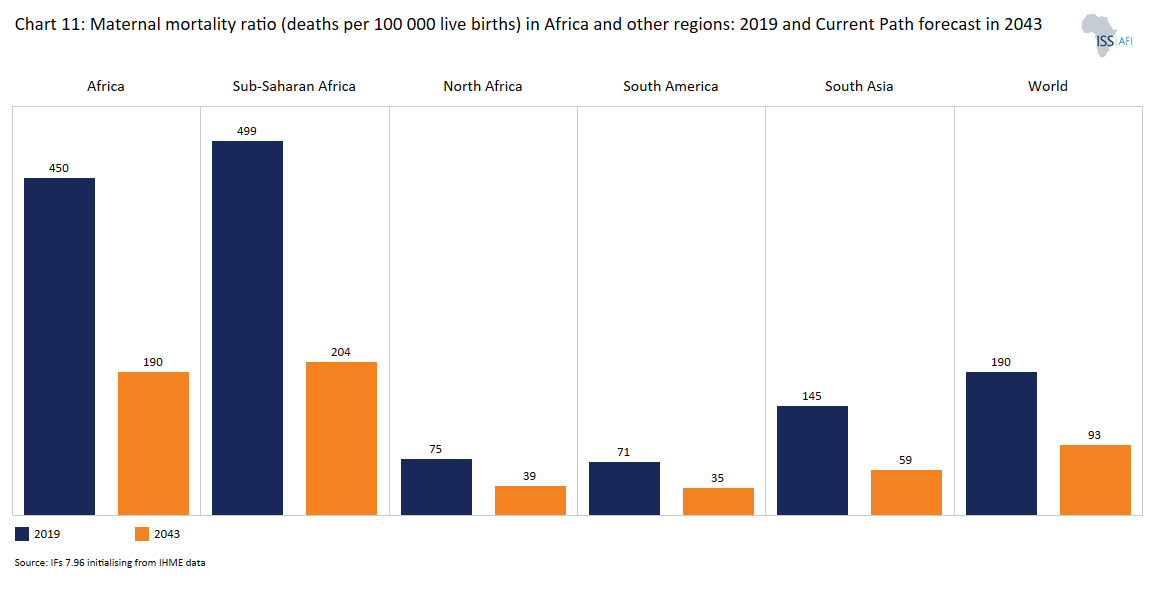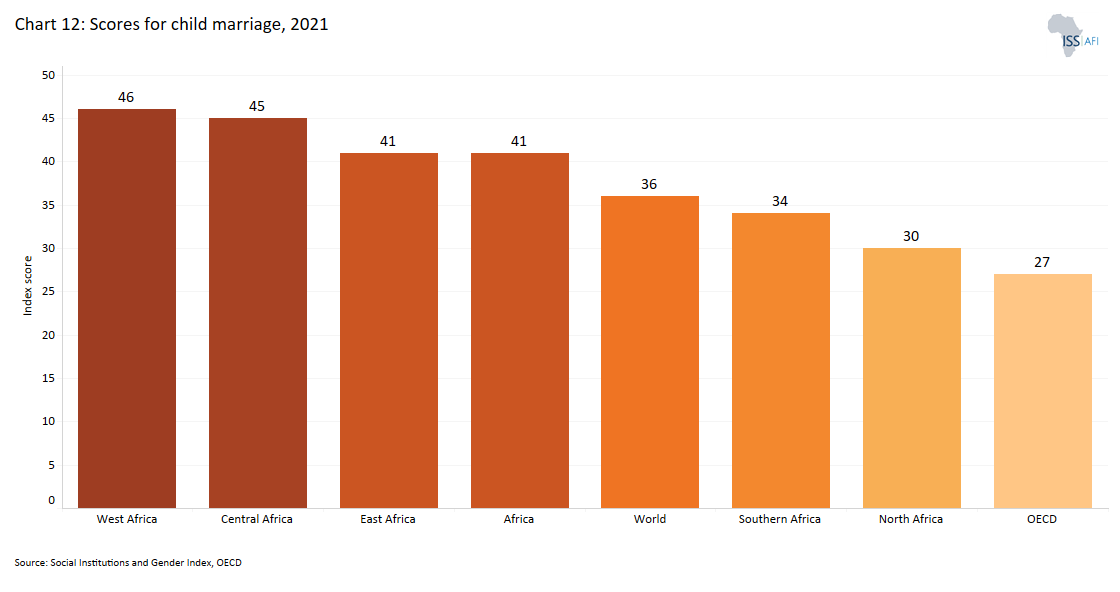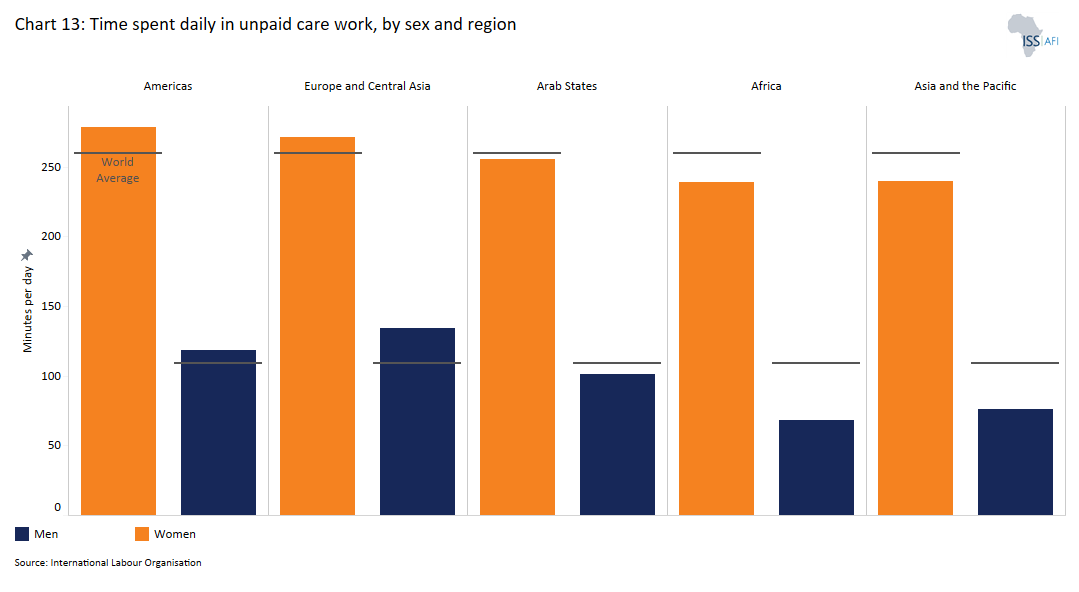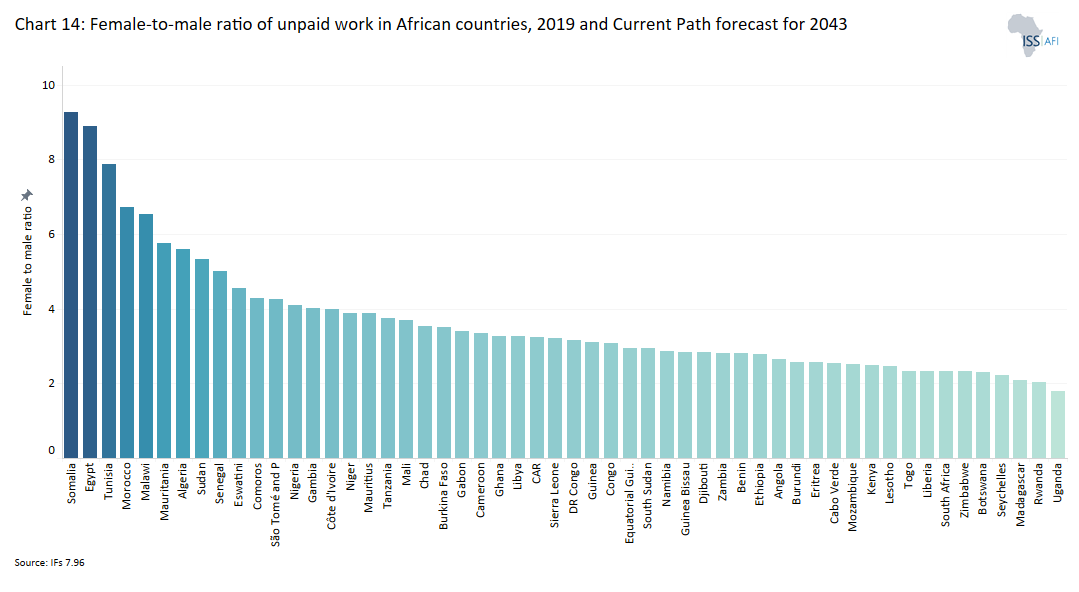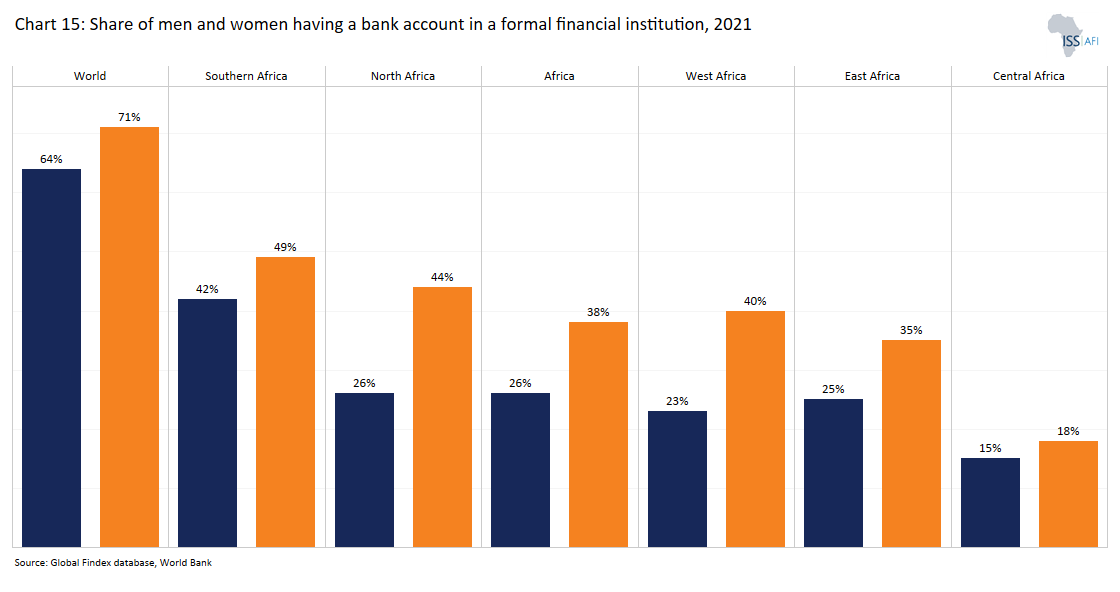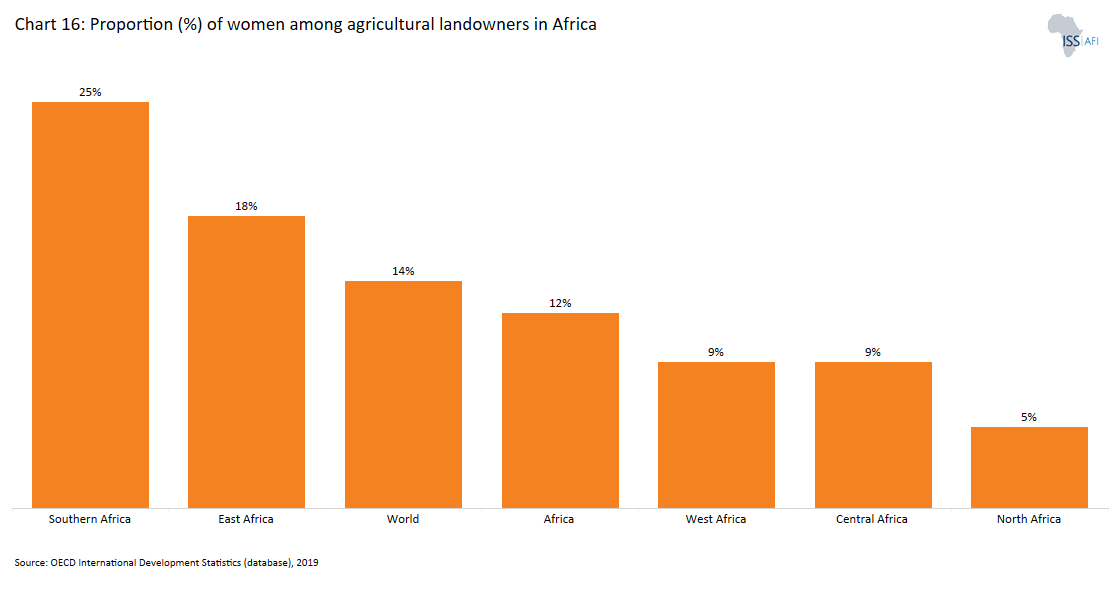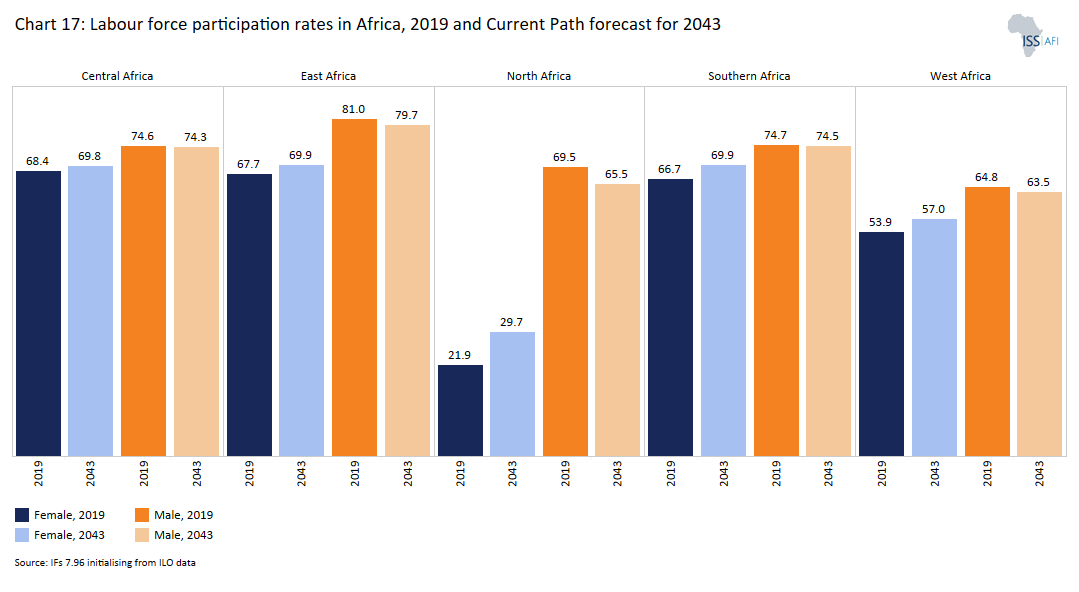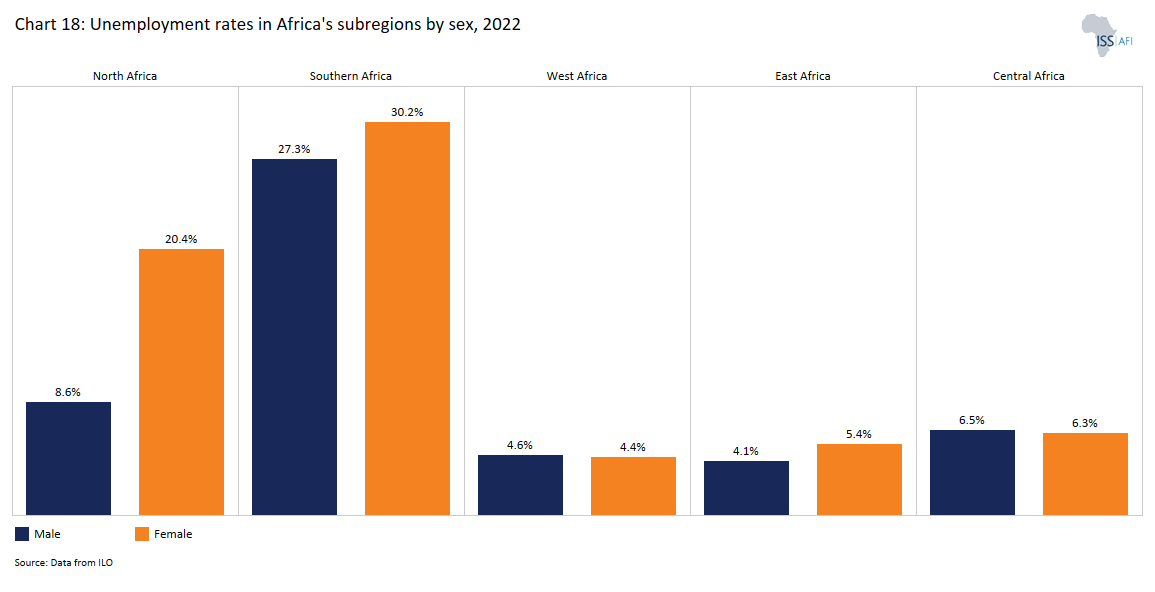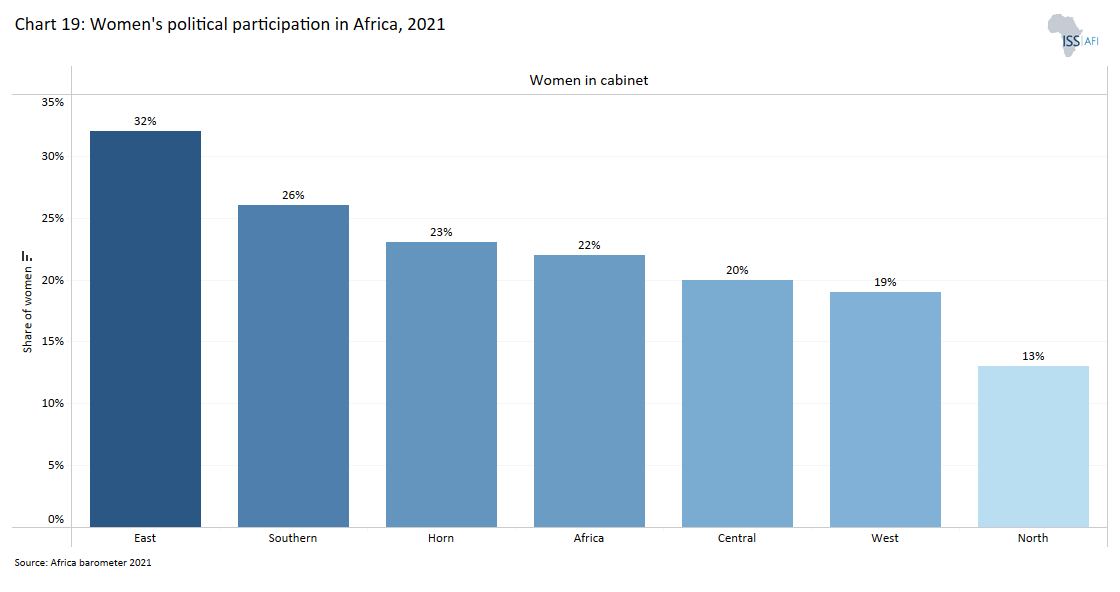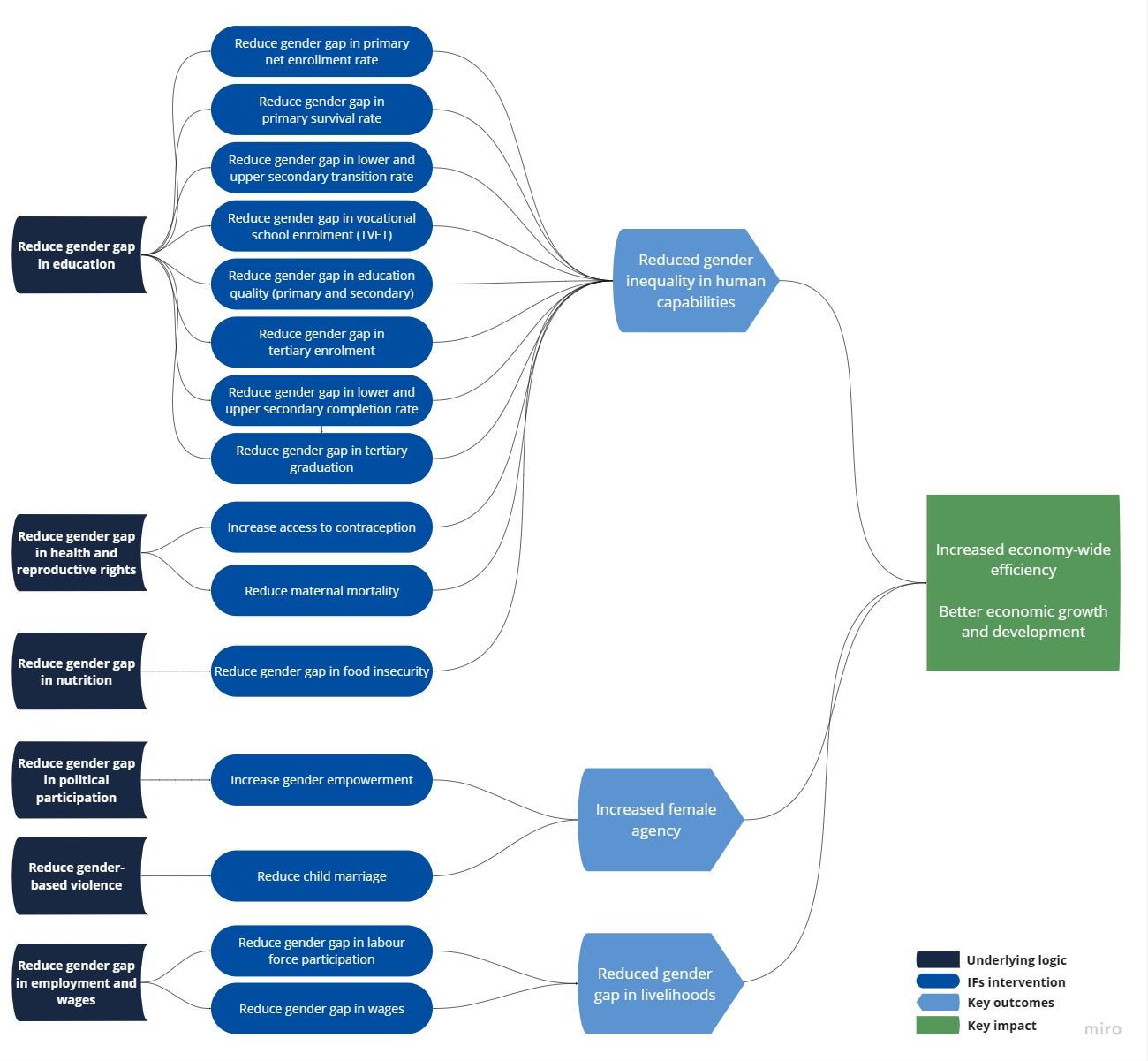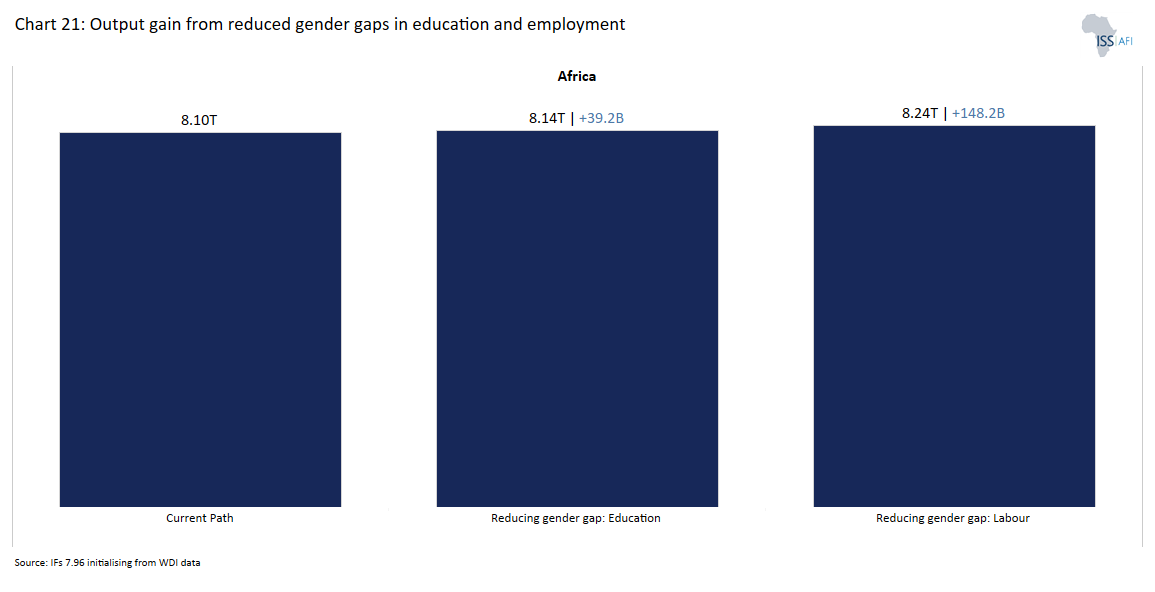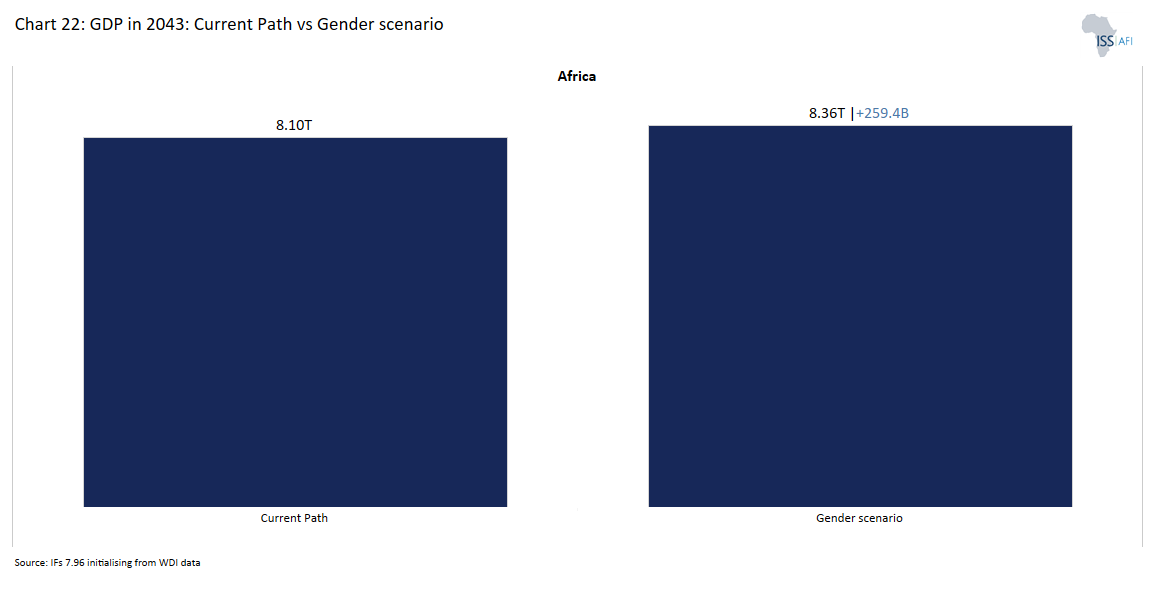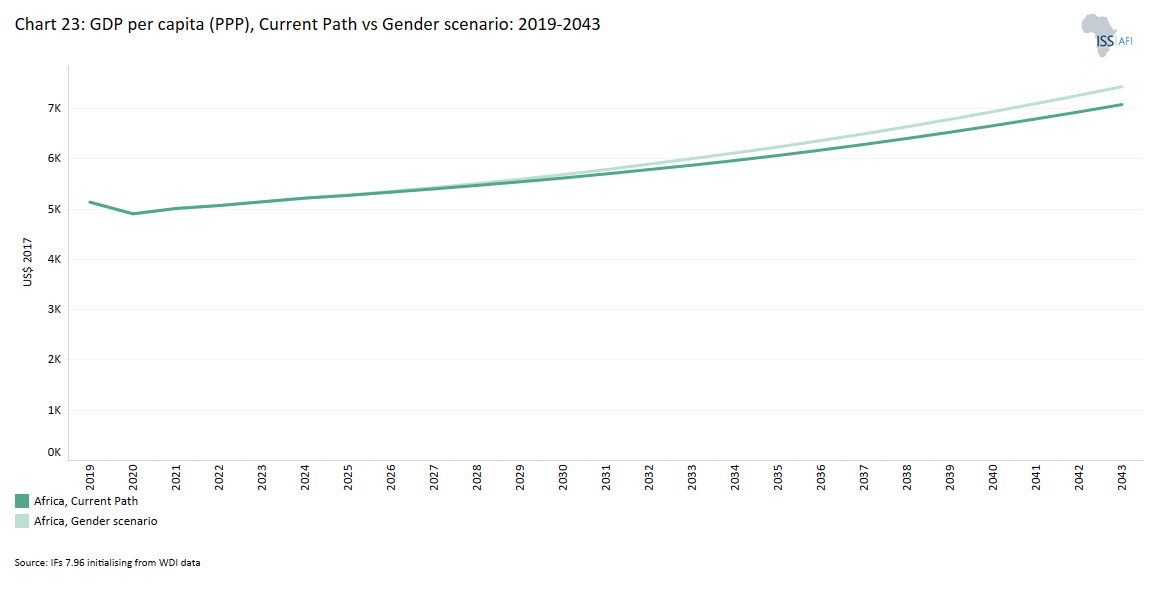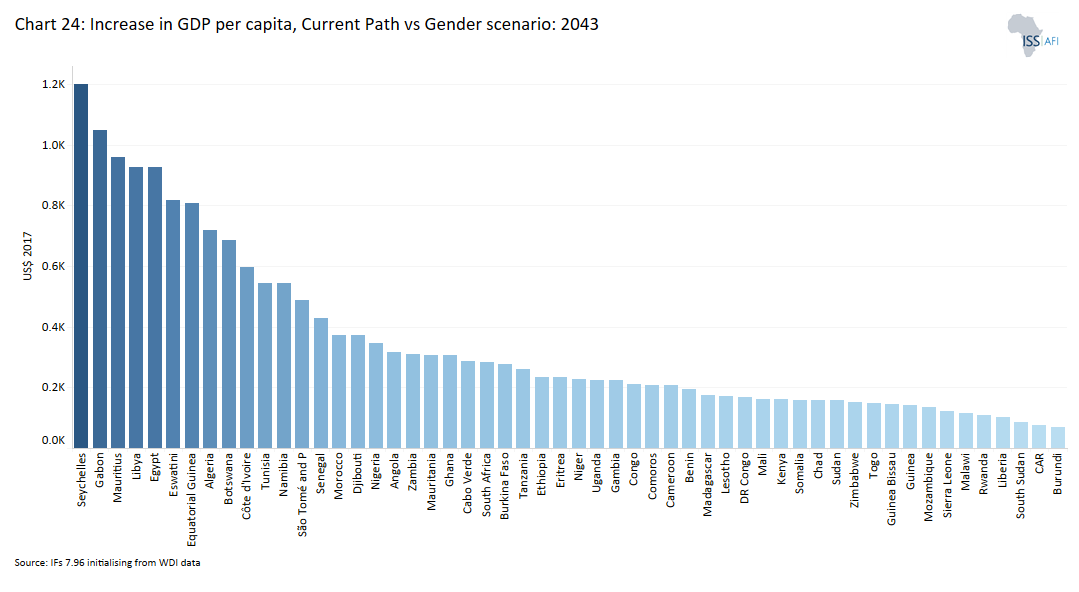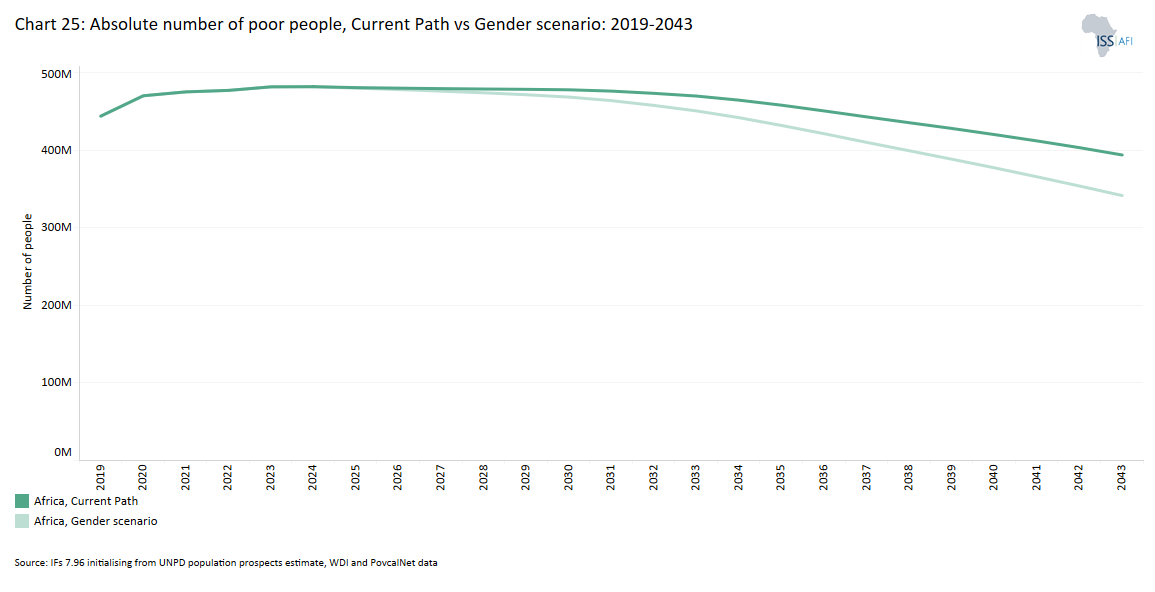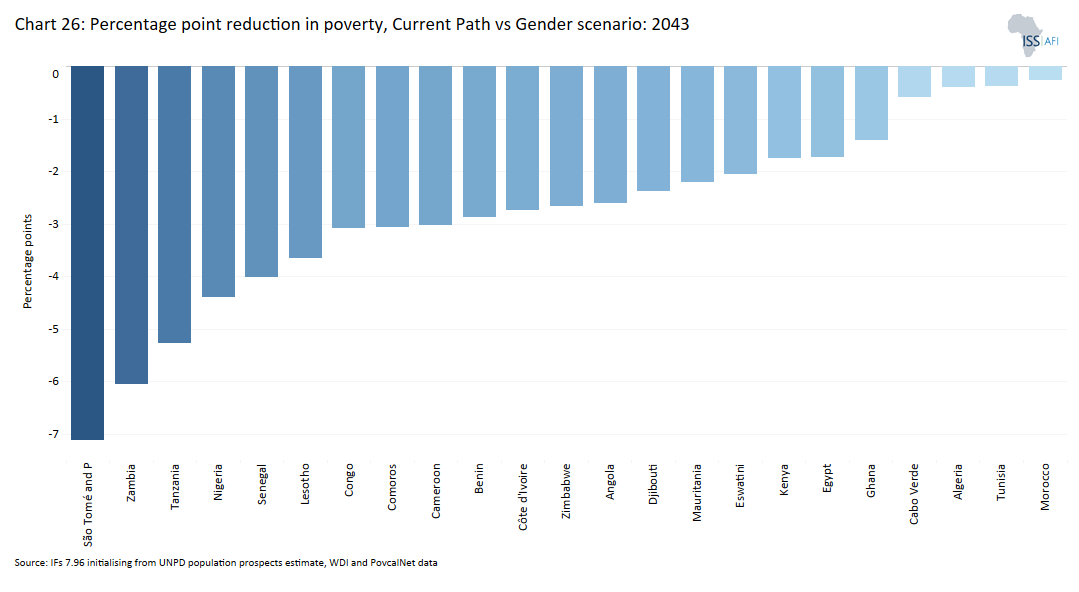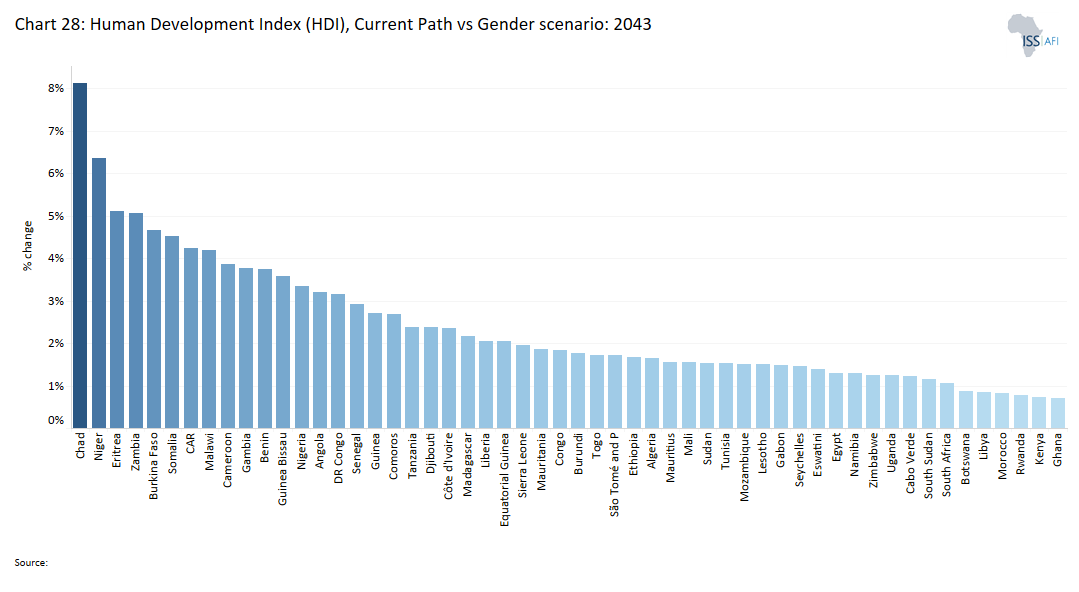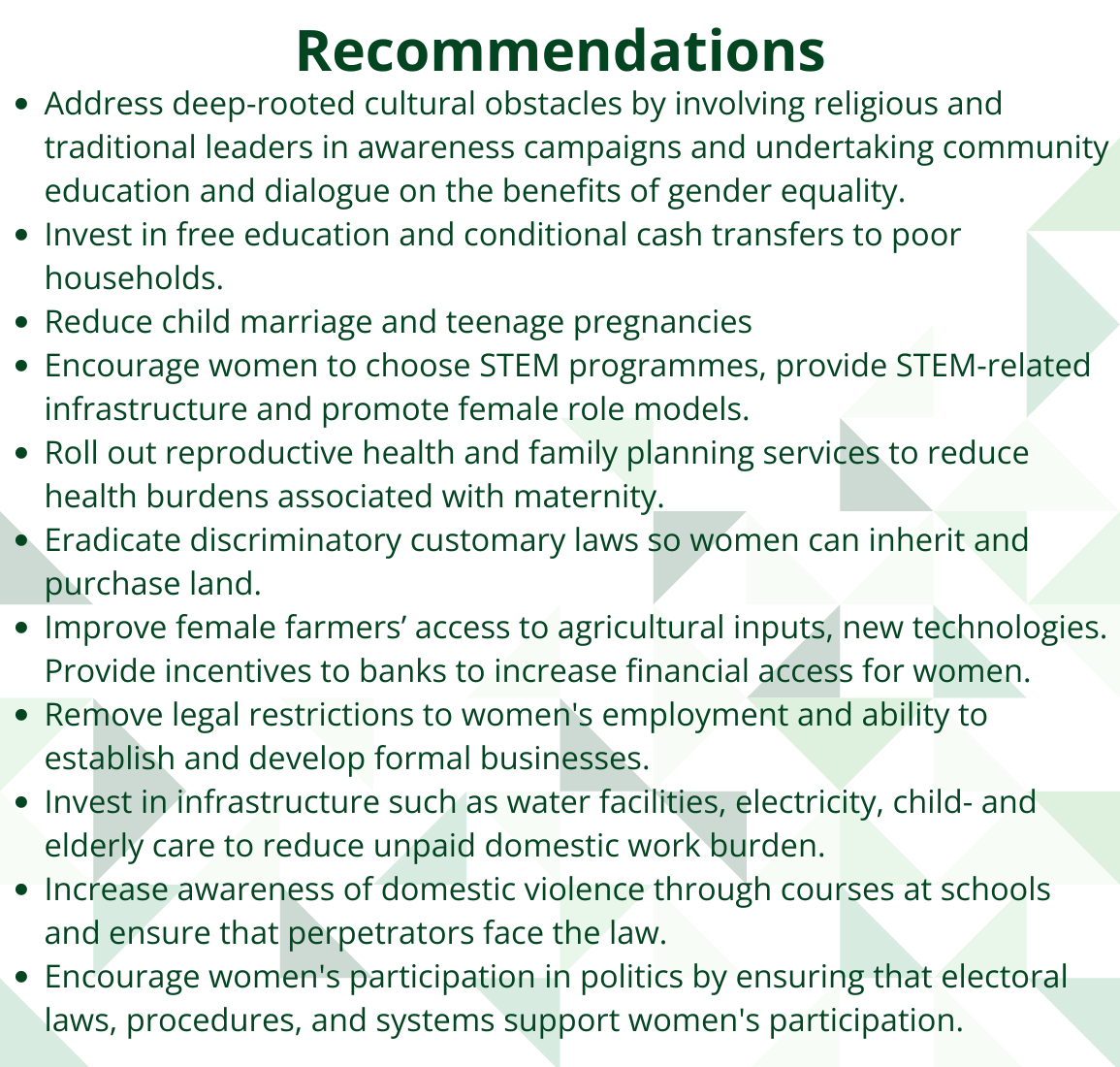 16 Gender
16 Gender
Feedback welcome
Our aim is to use the best data to inform our analysis. See our Technical page for information on the IFs forecasting platform. We appreciate your help and references for improvements via our feedback form.
This page presents an overview of the key gender inequalities in Africa and explores likely trends in a business-as-usual scenario (or Current Path) to 2043. It examines the impact of reducing gender inequalities across the continent through two scenarios: an ambitious but reasonable reduction in gender gaps and full gender equality. The analysis assesses the challenges but also the significant economic and social benefits of such efforts, with the understanding and acknowledgement that full equality is not practically achievable in the near future. For more information about the International Futures modelling platform we use for our scenarios, please see About this Site.
Summary
We begin this theme with providing an introduction to the policy context around gender in Africa.
We then assess key gender inequalities and likely trends in a business-as-usual scenario (or Current Path) across all African states until 2043, the end of the third ten-year implementation plan of the African Union’s Agenda 2063. These challenges include education, health, discrimination, economic participation and political representation.
- Africa has significantly reduced gender inequality in education, especially at primary and secondary levels, but females still face barriers to accessing education. Girls in sub-Saharan Africa are today the most disadvantaged regarding access to schooling compared to other regions.
- African women are more likely to die from communicable diseases (e.g. HIV, tuberculosis and malaria) and nutritional deficiencies than men.
- Although declining, child marriage is still widespread. Globally, nine out of ten countries with the highest levels of child marriage are in Africa, namely Niger, the Central African Republic, Chad, Mali, Mozambique, Burkina Faso, South Sudan, Guinea and Nigeria.
- Women bear most of the burden regarding unpaid care and domestic work in Africa. On average, women spend 4.1 times more time than men on unpaid care and domestic work.
- Women in Africa are often significantly disadvantaged in divorce and inheritance due to cultural norms, traditional practices and legal frameworks that prioritise male interests and perpetuate gender inequality.
- African women often have fewer opportunities to get loans from financial institutions than men and have limited access to productive resources such as land, agricultural inputs, equipment and extension services.
- Gender inequality in employment is still pervasive in Africa. North Africa has the highest gender gap in labour force participation rate on the continent.
- Gender-based occupational segregation and the gender wage gap are also common matters. Women tend to be concentrated in low-skilled and low-paying sectors while men are overrepresented in higher-paying sectors.
- Despite an overall increase in women involved in politics, leadership and decision-making, Africa is still far from achieving women's equal and effective participation in political decision-making.
- Climate change worsens gender inequalities in Africa.
We then proceed with modelling two scenarios which present the impact of reductions in gender inequality: the Gender scenario and the Gender Equality scenario.
- The Gender scenario reflects an ambitious but realistic reduction in gender inequalities using the progress made by other countries or regions at similar levels of development as a benchmark. It sees the 2043 African economy being about US$259 billion (or 3.3%) larger than what is projected in the Current Path in the same year. GDP per capita would increase by 5% and 53 million Africans would be lifted out of extreme poverty.
- The illustrative Gender Equality scenario emulates the impact of full equality by 2043, which would result in an economy that is US$1 trillion larger than the Current Path. GDP per capita would be 12% higher and Africa would have 80 million fewer persons in extreme poverty.
Following from this scenario analysis we discuss how Africa can address gender inequalities and challenges. Reducing gender gaps or achieving full gender equality could significantly improve Africa’s development prospects. Addressing gender inequalities is growth-promoting, reduces poverty and improves human development. The conluding section of this page offers key recommendations for decision-making.
All charts for Theme 16
- Chart 1: Gender Gap Index per region, 2022
- Chart 2: Gender parity, mean years of education (aged 15+), Africa and other regions
- Chart 3: Definitions/terminology in education
- Chart 4: Gender parity (net primary enrolment) in Africa and other regions, 2019 and Current Path forecast in 2043
- Chart 5: Gender parity (gross secondary enrolment) in Africa and other regions, 2019 and Current Path forecast in 2043
- Chart 6: Gender parity (gross tertiary enrolment) in Africa and other regions, 2019 and Current Path forecast in 2043
- Chart 7: Gender parity (primary completion) in Africa and other regions, 2019 and Current Path forecast in 2043
- Chart 8: Gender parity (secondary completion) in Africa and other regions, 2019 and Current Path forecast in 2043
- Chart 9: Gender parity (tertiary graduation) in Africa and other regions, 2019 and Current Path forecast in 2043
- Chart 10: Gender Gap Index in education, 2022
- Chart 11: Maternal mortality ratio (deaths per 100 000 live births) in Africa and other regions, 2019 and Current Path forecast in 2043
- Chart 12: Scores for child marriage, 2021
- Chart 13: Time spent daily in unpaid care work, by sex and region
- Chart 14: Female-to-male ratio of unpaid work in African countries, 2019 and Current Path forecast for 2043
- Chart 15: Share of men and women having a bank account in a formal financial institution, 2021
- Chart 16: Proportion (%) of men and women among agricultural landowners in Africa
- Chart 17: Labour force participation rates in Africa, 2019 and Current Path forecast for 2043
- Chart 18: Unemployment rates in Africa’s subregions by sex, 2022
- Chart 19: Women's political participation in Africa, 2021
- Chart 20: Gender scenario
- Chart 21: Output gain from reduced gender gaps in education and employment in Africa
- Chart 22: GDP in 2043: Current Path vs Gender scenario
- Chart 23: GDP per capita (PPP), Current Path vs Gender scenario: 2019-2043
- Chart 24: Increase in GDP per capita, Current Path vs Gender scenario: 2043
- Chart 25: Absolute number of poor people (US$1.90): Current Path vs Gender scenario
- Chart 26: Percentage points reduction in poverty rate (US$1.90): Current Path vs Gender scenario, 2043
- Chart 27: Stunted children: Current Path vs Gender scenario, 2019 to 2043
- Chart 28: Human Development Index (HDI) in the Gender scenario: percentage change compared to the Current Path in 2043
- Chart 29: The size of the African economy in 2043: Current Path vs Gender and Gender Equality scenario
- Chart 30: GDP per capita (PPP), Current Path vs Gender and Gender Equality scenario
- Chart 31: Absolute number of poor people: Current Path vs Gender scenario and Gender Equality scenario
- Chart 32: Summary of policy proposals to reduce or eliminate gender gaps
Gender inequality refers to the disadvantage that one gender has compared to another regarding access, opportunities and representation in the social, economic and political spheres, including the share in decision-making power at all levels. It also refers to disadvantage among the group of women and disadvantage among the group of men.[1K Crenshaw, Why intersectionality can’t wait, The Washington Post, 24 September 2015.]
No country or region has achieved full gender parity, although some countries and regions have made more progress than others (Chart 1). Recent shocks, such as the COVID-19 pandemic and its associated economic crisis, seem to have reversed progress towards parity. According to the United Nations Development Programme (UNDP),[2UNDP, Human Development Report 2021/2022: Uncertain Times, Unsettled Lives: Shaping our Future in a Transforming World, 2022. The Gender Inequality Index is a composite measure of gender inequality using three dimensions: reproductive health, empowerment and the labour market.] most regions, including all regions in Africa, experienced a decline in their Gender Inequality Index score from 2019 to 2021.
Similarly, the UNDP 2023 Gender Social Norms Index report found no improvement in biases against women in the last decade. About half of the world's people still think men make better political leaders than women, and more than 40% think men make better business leaders than women, while 25% think it is justified for a man to beat his wife.[3The United Nations Development Program (UNDP) Gender Social Norms Index comprises four dimensions— political, educational, economic and physical integrity. It is constructed based on responses to seven questions from the World Values Survey, which are used to create seven indicators. The core index value measures the percentage of people with at least one bias, and a lower value indicates less bias. See: UNPD, 2023 Gender Social Norms Index (GSNI): Breaking down gender biases: Shifting social norms towards gender equality, New York: UNDP, 2023.]
Africa has made significant progress in adopting several protocols and directives that are aimed at achieving gender equality. At the international level, they include the Universal Declaration of Human Rights (1948); the Convention on the Rights of the Child (1989); the Convention on the Elimination of all Forms of Discrimination Against Women (CEDAW) (1979); the Beijing Declaration and Platform for Action (adopted at the Fourth World Conference on Women in Beijing in 1995); the United Nations Security Council Resolution 1325 (UNSCR 1325 adopted in 2000);[4The resolution focuses on women, peace, and security. It recognises the impact of armed conflict on women and highlights the importance of women's participation in conflict prevention, resolution and peacebuilding efforts.] the Millennium Development Goals (MDGs) and the Sustainable Development Goals (SDGs); the Rome Statute of the International Criminal Court, which includes provisions addressing gender-based crimes, such as rape, sexual slavery, and forced pregnancy, as war crimes and crimes against humanity; and several International Labour Organization (ILO) conventions related to women's rights in the workplace, including Convention No. 100 on Equal Remuneration and Convention No. 156 on Workers with Family Responsibilities.
At the regional level, the list is equally impressive. It includes the African Charter on Human and People’s Rights (1986); the African Charter on the Rights and Welfare of the Child[5The ACRWC was adopted by the Organisation of African Unity on 11 July 1990 and came into force on 29 November 1999.] (ACRWC/the Charter); the Maputo Protocol to the African Charter on the Rights of Women (2003); the Protocol to the African Charter on Human and Peoples' Rights on the Rights of Women in Africa in Conflict and Post-Conflict Situations (2009);[6Adopted in 2009, this protocol complements the Maputo Protocol and focuses specifically on the protection and empowerment of women in conflict and post-conflict situations.] the 2004 Solemn Declaration on Gender Equality in Africa (SDGEA);[7The SDGEA reaffirms the commitment of African leaders to promote gender equality on the continent. It calls for specific actions to address gender disparities and empower women in various sectors, including education, health and political participation.] and the African Union Policy Framework on Gender Equality (2010).[8This policy framework sets out guidelines and strategies for African Union member states to promote gender equality and women's empowerment in different areas of development.]
Likewise, the African Union's Agenda 2063, a master plan for ‘the Africa we want’, places gender equality at the forefront of the continent's vision. Among the seven aspirations outlined in the agenda, Aspiration 6 and its related Goal 17 specifically focus on achieving full gender equality to enable a people-driven development for Africa.[9African Union, African Union priorities on gender equality and women’s empowerment in Agenda 2063, 28 July 2021.] Several regional bodies, such as the Economic Community of West African States (ECOWAS), the Southern African Development Community (SADC) and the East African Community (EAC) also have protocols on gender equality.
Despite this plethora of policies, protocols and conventions, achieving gender equality remains a distant prospect on the continent. For instance, sub-Saharan Africa is the worst-performing region in the UNDP’s Gender Inequality Index.
According to a report by McKinsey,[10McKinsey Global Institute, The power of parity: Advancing women’s equality in Africa, 24 November 2019.] Africa's overall gender parity stands at 0.58 (1 would be full parity). Given the current rate of progress, it could take 140 years for the continent to achieve full equality. This alarming forecast calls for drastic actions to address gender inequalities on the continent not only for its intrinsic value, i.e. to improve upon the well-being of all human beings, but also because of its potential economic benefits.
For instance, the 2016 UNDP Human Development Report indicates that the total annual economic losses caused by gender gaps in sub-Saharan Africa reached US$95 billion between 2010 and 2014.[11UNDP, Africa Human Development Report: Accelerating gender equality and women’s empowerment in Africa, UN: New York, 2016.] Also, the 2021 Social Institutions and Gender Index (SIGI) Regional Report by the OECD estimates that discriminatory social institutions cost Africa the equivalent of 7.5% of its GDP in 2019.[12OECD, Social Institutions and Gender Index (SIGI) Regional Report for Africa, OECD Development Centre, 2021.] These findings suggest that Africa could reap a substantial growth dividend if it fully uses the skills and talents of all its citizens — including its girls and women.
The literature has no clear-cut conclusion regarding the relationship between gender equality, growth and development. Even though most theoretical and empirical studies conclude that reducing gender gaps is associated with high economic growth, some studies claim that existing evidence is weak and hence cannot support the claim that policies aimed at reducing gender inequality promote economic growth.[13O Bandiera and A Natraj, Does gender inequality hinder development and economic growth? Evidence and policy implications, The World Bank Research Observer, 28: 2–21, 2013.]
This theme models the impact of a more rapid reduction in gender inequalities in the social, economic and political spheres on development outcomes in Africa with a forecast horizon to 2043, the end of the third ten-year implementation plan of the African Union’s Agenda 2063.
Despite the significant progress made in the area of policy and legislation and the ratification of international and regional conventions and commitments by African countries, gender inequalities persist as a significant social issue. They affect various aspects of life, including education, employment, political representation, healthcare and access to resources. The subsequent sections below provide an overview of the key gender inequalities and likely trends in a business-as-usual scenario (or Current Path forecast) across all African states. It serves as a departure point for the subsequent development of an ambitious scenario on reduced gender inequality and quantification of the associated impact. The analysis frequently compares Africa and sub-Saharan Africa to other developing regions to gauge the continent's progress on gender-related indicators.
A separate theme on education models the impact of an ambitious scenario on improving the quality, quantity and job relevance of education. Here we primarily focus on quantity.
Globally, the dimension of gender inequality, where progress has been most pronounced and widespread, has been in the quantity of education provided to females compared to males. Chart 2 shows the trends in the ratio of females' mean years of education to males' in African countries and other important regions. The ratio improved from 0.5 in 1960 to 0.8 in 2019 (where 1 is full parity), on par with South Asia. This represents significant progress, given that improving educational outcomes takes time. However, this ratio is below the world average of 0.9 and the parity levels obtained in South America. Indeed, South America achieved gender parity in terms of mean years of education in the 1990s. On the Current Path, Africa will not achieve full parity over the forecast horizon, as the ratio will only improve to 0.9 in 2043.
Examining gender parity trends across different levels of education reveals disparities. Trends are more favourable when considering primary and secondary school enrolments, as there has been a significant improvement in the share of African girls receiving primary education.
Subsequent subsections present gender parity at primary, secondary and tertiary levels, starting with enrolment rates followed by completion rates.
Chart 4 shows the female/male ratio of net primary school enrolment in Africa, as well as a selection of global groups in 2019 (pre-pandemic level) and the Current Path forecast for 2043. In 2019, 94 girls were enrolled in primary school for every 100 boys in Africa, which is below the averages for other developing regions but an improvement from the level of 90 girls for every 100 boys in 2000. This is due to the relatively low gender parity ratio in sub-Saharan Africa, with 93 girls enrolled in primary school for every 100 boys in 2019. North Africa has achieved gender parity in net primary school enrolment.
In 32 African countries, the female-to-male ratio of net primary school enrolment is above 1, meaning that for every 100 boys, there were more than 100 girls enrolled in primary school in 2019. In other words, gender inequality in net primary school enrolment in these countries is skewed in favour of girls. Countries such as Egypt, Gabon and Lesotho have achieved full parity, while Nigeria and Angola have the lowest ratios at 0.74 and 0.68, respectively.
Also, looking at the gross primary enrolment (not shown on the chart), 99 girls were enrolled in primary school for every 100 boys in Africa in 2019. This is on par with the world average and an improvement from a ratio of 0.86 in 2000 (i.e. 86 girls for every 100 boys). In some African countries, such as Mauritius, Seychelles and Senegal, the female-to-male ratio of gross primary school enrolment is above 1, meaning that gender inequality in gross primary school enrolment affects boys in these countries. Some countries, such as Egypt, Kenya and Libya, have achieved full parity, while Chad and South Sudan had the lowest ratio at 0.78 and 0.71, respectively, in 2019.
On the current development trajectory, the female-to-male ratio of net primary school enrolment in Africa is forecast to be at 0.97 in 2043 — a relatively moderate improvement compared to its pre-pandemic level of 0.94 in 2019 (Chart 4). This is partly due to the COVID-19 pandemic that slowed progress, as many girls did not return to school after the pandemic. A study by the World Bank suggests that girls were 1.2 times more likely to drop out of school than boys due to the impact of the COVID-19 pandemic.[14World Bank, Assessing the damage: Early evidence on impacts of the COVID-19 crisis on girls and women in Africa, 2022.] A similar study in Kenya found that the proportion of girls (16%) who did not return to school in 2021 after nearly a year of school closure was twice the rate for boys (8%).[15J Kincer and J Lovering, 2023 Update: Who in Africa is Ready for Nuclear Power? Energy for Growth Hub, 7 February 2023] This may be attributed to the likelihood of girls becoming pregnant during the lockdowns and school closures, as witnessed with other diseases like the 2014–2016 Ebola outbreak in West Africa.[16BO Ahinkorah et al, COVID-19 pandemic worsening gender inequalities for women and girls in sub-Saharan Africa, Frontiers in Global Women's Health, 2, 2021.]
Africa has also progressed at the secondary level, although it still trails other developing regions. Chart 5 shows the female-to-male ratio of gross secondary school enrolment for Africa and other global groups of countries. In 2019, 92 girls enrolled in secondary school for every 100 boys in Africa, which is below the world average and the averages for other developing regions. However, it is an improvement from a ratio of 0.89 in 2000 (89 girls for every 100 boys). North Africa has achieved full parity, whereas sub-Saharan Africa has the lowest ratio at 0.9 (90 girls enrolled in secondary school for every 100 boys) among all the world regions. Despite North Africa's poor reputation regarding the rights of girls and women, the region has achieved gender parity in primary and secondary school enrolment. Therefore, achieving full parity in primary and secondary school enrolment in Africa hinges on progress in sub-Saharan Africa.
The situation also varies between African countries. In 2019, 20 African countries enrolled more girls in secondary school than boys (female-to-male ratio above 1). Fourteen countries have a ratio above 0.9 and eight are above 0.8. South Sudan and Chad have the lowest ratios at 0.64 and 0.52, respectively, mainly due to cultural traditions, conflict and security issues as well as early marriage and forced marriage.[17United Nations Office for the Coordination of Humanitarian Affairs (OCHA), Chad: Investing in girls' education, Reliefweb, 2016.]
On the Current Path, girls’ and boys' access to secondary education will continue to improve in Africa, but full parity will likely not be achieved as the female-to-male ratio of gross secondary school enrolment is forecast to be 0.98 in 2043 (where 1 would be full parity). This is due to relatively slow progress in sub-Saharan Africa, as the region reaches a ratio of 0.97 in 2043 compared to a ratio of 1 (full parity) for North Africa in the same year.
Chart 6 shows the female-to-male ratio of gross tertiary enrolment for Africa and other developing regions. Except for sub-Saharan Africa and South Asia, all the other developing regions have more women enrolled in tertiary institutions than men. In 2019, 93 women enrolled in tertiary educational institutions for every 100 men in Africa, which is far below the world average and the averages for other regions. Sub-Saharan Africa has the lowest ratio globally, with only 80 women enrolled for every 100 men at tertiary level. Some countries, such as Burundi, Chad, Central African Republic and Somalia, have even lower levels, with fewer than 50 women per 100 men in tertiary educational institutions. On average, in North Africa, more women are enrolled in tertiary educational institutions than men, implying that gender inequality at this level of education affects males in the region; this trend is forecast to continue until at least 2043. On the Current Path, sub-Saharan Africa is projected to achieve full parity in 2036, although by 2043, there will likely be slightly more females at the tertiary level than males (Chart 6).
Overall, Africa has made significant progress in enrolling its girls and women in school, even though sub-Saharan Africa still trails the world's average and regions such as North Africa, South America and South Asia. Getting girls into school is important, but ensuring they stay and graduate is essential.
Chart 7 shows the female-to-male ratio of primary school completion rates in Africa and other regions. In 2019, on average, 98 girls completed primary education for every 100 boys in Africa. This is below the world average (102 girls for 100 boys) and the averages for other regions.
Sub-Saharan Africa has the lowest ratio globally, with 97 girls for every 100 boys. About 80% of African countries have a female-to-male ratio of primary school completion rates above 0.90, with countries such as South Sudan, Central African Republic and Chad trailing far behind. However, the reverse is the case in North Africa. On average, more girls complete primary education than boys, which, on the Current Path, is expected to continue until at least 2043. On the Current Path, sub-Saharan Africa is projected to achieve full parity in 2028, although by 2043, there will likely be slightly more girls completing primary education than boys (Chart 7).
Chart 8 shows the female-to-male ratio of lower and upper secondary completion rates for Africa and other regions in 2019 and includes a forecast for 2043. In 2019, 96 girls completed lower secondary education for every 100 boys in Africa, which is below the world average but above the average for South Asia. In the same year, 95 girls completed upper secondary school for every 100 boys in Africa; this is below the world average and the averages for South Asia and South America.
In 2019, sub-Saharan Africa had the lowest female-to-male ratio of upper secondary completion rates among all the regions. The completion rates in North Africa for the same period were much higher at 98 girls for every 100 boys and more than 100 girls for every 100 boys for upper secondary education.
On the Current Path, Africa's female-to-male ratio of lower and upper secondary completion rates is forecast to improve to 0.99 and 1.03 in 2043, respectively.
At the country level, there are marked differences. The gender completion gap is even reversed in favour of females, with more girls than boys completing upper secondary school in some African countries such as Algeria, Mauritius, Morocco, South Africa, Tunisia, Egypt and Seychelles, among others.
In contrast to other levels, progress in reducing gender inequality in tertiary graduation has been slow in sub-Saharan Africa. In 2019, only 65 women graduated from tertiary institutions for every 100 men in sub-Saharan Africa, the lowest among all the world regions. In North Africa, however, there are more female tertiary graduates than male. Sub-Saharan Africa's low performance, driven by the poor performance in Central Africa, explains the low average ratio of Africa compared to other developing regions (Chart 9). On the Current Path, sub-Saharan Africa will likely achieve full parity in 2034, although the graduation rate for females at tertiary level will probably be higher than that of males afterwards, mimicking global trends.
In summary, Africa has significantly reduced gender inequality in education, especially at primary and secondary levels. Gross primary school enrolment is high or universal in most African countries, and gender gaps in secondary school enrolment have already disappeared in several countries. The situation is even reversed in some countries, mainly North African countries, with more females than males enrolled in secondary and tertiary schools.
Despite this progress, females still face barriers to accessing education in many parts of Africa. Fewer girls than boys are enrolled in technical and vocational education and training (TVET), and science, technology, engineering and mathematics (STEM) programmes. Furthermore, fewer girls in Africa are literate than boys. In the Africa Gender Index from the African Development Bank, the average score of Africa for youth literacy rate stands at 87 on a scale from 0 to 100 (where 100 is full parity). The situation is worse for STEM, with a score of 38.[18The African Gender Index is a composite index developed jointly by the African Development Bank and the United Nations Economic Commission for Africa. It measures parity between women and men across three dimensions: economic, social and representation and empowerment. A value of 1 indicates perfect equality between females and males, and 0 perfect inequality, while a value greater than 1 indicates that females are doing better than males (inequality hurting males). Djibouti, Equatorial Guinea and South Sudan are not included due to data constraints.] However, the scores for different countries range widely, reflecting considerable variation in access to education for African women.
It is worth noting that the low enrolment of girls in STEM programmes is not necessarily the result of discrimination in admission. Even in countries that empower women, fewer females choose STEM programmes than males,[19The Journal, A gender equality paradox: Countries with more gender equality have fewer female STEM grads, 18 February 2018.] probably due to the narrative about how difficult it is to pursue a STEM career, psychosocial factors and limited role models.
Looking at the overall gender inequality in education (Chart 10), girls in sub-Saharan Africa are today the most disadvantaged regarding access to schooling compared to other regions. The United Nations Children’s Fund (UNICEF) reports that nine million girls in Africa between the ages of 6 and 11 never go to school, compared to six million boys in the same age category.[20UNESCO Institute for Statistics, Education in Africa.] In Nigeria, for instance, about 60% of the 10 million out-of-school children are girls, according to UNICEF.
Many factors, such as early marriage, teenage pregnancy, gender-based violence, intra-household division of labour, poverty and insufficient or inadequate school infrastructure, limit opportunities for girls to access education in sub-Saharan Africa.[21The World Bank, Girls’ education.] Even if opportunities are available, the social norm of valuing boys over girls means some parents place a lower premium on their daughters’ education.
High teenage pregnancy rates in many African countries serve to disrupt education. Every year, hundreds or thousands of school girls get pregnant in sub-Saharan Africa — a situation exacerbated during the COVID-19 pandemic lockdown. For example, over a period of three months in the lockdown due to COVID-19, 152 000 Kenyan teenage girls got pregnant — a 40% increase in the country's monthly average.[22S Partridge-Hicks, Rise in teenage pregnancies in Kenya linked to COVID-19 lockdown, Global Citizen, 19 August 2020.] Côte d'Ivoire also recorded 3 409 cases of pregnancies in schools from September 2021 to May 2022.[23APA, Côte d'Ivoire: 3409 grossesses en milieu scolaire de septembre 2021 à mai 2022, Abidjan.net, 1 juin 2022.] Girls get pregnant because they lack access to sex education and/or are coerced into sex due to poverty.[24ReliefWeb, Africa: Make girls’ access to education a reality, 15 June 2017.]
Although most sub-Saharan African countries have committed to guaranteeing compulsory primary and lower secondary education for all children, many have policies and practices that effectively prevent pregnant school girls and young mothers from returning to school.[25ReliefWeb, Africa: Make girls’ access to education a reality, 15 June 2017.] Some countries, such as Cameroon, South Africa and Zambia, have adopted policies that allow adolescent mothers to return to school after giving birth. However, school officials often fail to effectively implement these policies.[26ReliefWeb, Africa: Make girls’ access to education a reality, 15 June 2017.] As a result, millions of girls in Africa are denied their education.
Given the potential benefits of female education, promoting a culture of equality in education should be a top governmental priority everywhere in Africa. Education increases women's earning capacity and makes them healthier, and their children inherit these advantages. It is estimated that if all women completed primary school, the number who die in pregnancy and childbirth would fall by about two-thirds.[27The Economist, Why educating girls is even more important than people realise, 19 August 2021] Girls who spend more time in school are also much less likely to become child brides or teenage mothers and are also less likely to suffer domestic violence.[28The Economist, Why educating girls is even more important than people realise, 19 August 2021]
Moreover, education is an important contributor to economic growth through its effect on human capital stock and labour productivity. Therefore, unequal access, irrespective of gender, reduces the average stock of human capital in a society and thus undermines economic growth. However, in the case of women, access to education also reduces fertility and child mortality and enables the next generation's education. When girls are educated, the opportunity cost of childbearing becomes higher.[29D Dollar and R Gatti, Gender inequality, income and growth: Are good times good for women?, Policy research report on gender and development working paper series, No. 1, Washington, DC: World Bank Group.] As a result, they tend to trade off the quantity of their children for their quality, reducing the fertility rate. As fertility falls, the working-age population grows much faster than the overall population, thus lowering dependency rates and leading to higher savings, investments and a higher capital per worker. This results in a positive effect on economic growth known as the demographic dividend, or a demographic gift, as we examine in a separate theme on demographics. In this regard, some studies have shown that about one-third of economic growth during the East Asia economic miracle was attributed to the large worker bulge and relatively small number of dependants.[30D Canning, S Raja and AS Yazbeck (eds.), Africa’s demographic transition: Dividend or disaster?, Africa Development Forum Series, Washington, DC: World Bank, 2015.]
Separate themes on health and demographics examine associated aspects, and we model the impact of an ambitious Health and Demographics scenario separately and as part of the Combined Agenda 2063 scenario. The focus of this theme is the extent to which gender inequality impacts health.
African women are more likely to die from communicable diseases, such as HIV, tuberculosis and malaria, and nutritional deficiencies than men. Sub-Saharan Africa is the region with the most prominent HIV/AIDS epidemic globally, with women disproportionately affected by this infectious disease. For example, in 2018, women accounted for about 59% of new HIV infections of individuals aged 15 and older.[31UNAIDS, We’ve got the power: Women, adolescent girls and the HIV response, 2020.]
Lack of access to sexual and reproductive health and rights jeopardises the lives of many girls and women in Africa. An estimated 250 million women and girls in developing countries who want to avoid pregnancy are not using contraceptives due to the lack of access or support.[32The World Bank, Deliver the future: Catalyzing opportunities for women, children and adolescents, July 2023.] In sub-Saharan Africa, about 25% of women of reproductive age have an unmet need for contraception — the highest proportion globally.[33BO Ahinkorah, EK Ameyaw and AA Seidu, Socio-economic and demographic predictors of unmet need for contraception among young women in sub-Saharan Africa: Evidence from cross-sectional surveys, Reproductive Health, 17, 2020, 163.] Equality in reproductive health includes access, without discrimination, to affordable and quality contraception.[34The World Bank, Deliver the future: Catalyzing opportunities for women, children and adolescents, July 2023.] Also, many women in Africa die from preventable causes related to pregnancy and childbirth. The high maternal mortality on the continent has been linked to gender bias in the distribution of healthcare.[35F Chirowa, S Atwood and M Van der Putten, Gender inequality, health expenditure and maternal mortality in Sub-Saharan Africa: A secondary data analysis, African Journal of Primary Health Care & Family Medicine, 5:1, 2013, 471.]
Even though there has been an improvement in maternal healthcare in Africa in the last two decades, sub-Saharan Africa accounts for around 70% of the global maternal deaths.[36World Health Organization, Maternal mortality] In 2019 (pre-pandemic level), there were 450 maternal deaths per 100 000 live births in Africa, compared to the global average of 190. On the Current Path, the average maternal deaths in Africa are projected to decline to 340 deaths by 2030 and to 190 by 2043 (Chart 11), very different from the SDG target of 70 deaths per 100 000 live births. This is mainly due to the high number of maternal deaths in sub-Saharan Africa, as North Africa has almost achieved the SDG target related to this indicator (Chart 11).
A study conducted in East African countries shows that only 42.9% of women have access to healthcare in the region.[37A Minyihun and ZT Tessema, Determinants of access to health care among women in East African Countries: A Multilevel Analysis of Recent Demographic and Health Surveys from 2008 to 2017, Risk Management and Healthcare Policy, 13, 2020, 1803–813.] Another study also reveals that women in South Africa are more likely to suffer from poor health than men.[38M Ntuli et al, Gender inequalities in morbidity: A South African investigation, Studies in Economics and Econometrics, 40:3, 2016, 39–63.] However, a report by the United Nations Economic Commission for Africa (UNECA) indicates that male children under five years of age are more likely to become stunted than their female counterparts, suggesting that health investments are more favourable for girls than boys in the same age group.[39UNECA, African Gender and Development Index Regional Synthesis Report: Measuring Gender Equality and Women’s Empowerment in Africa, 2017.] Similarly, evidence shows men are more affected by tuberculosis and parasitic diseases in sub-Saharan Africa.[40NM Ratan, Sex differences in infectious diseases, News-Medical.Net.] Furthermore, like elsewhere, women in Africa, on average, live longer than men, although the gap narrows at higher levels of income and education, suggesting that broadening access to quality healthcare, diet and other advantages can help men achieve a level of longevity closer to that of women.[41Population Reference Bureau, Around the globe, women outlive men, 1 September 2001.]
There are several reasons for the difference in life expectancy between men and women, particularly in lifestyle. Men are more likely to smoke than women and are also more likely to engage in risky behaviour, making them more susceptible to life-threatening injuries. Biological differences also help to explain women’s higher longevity. For example, oestrogen in women combats conditions such as heart disease by helping reduce circulatory levels of harmful cholesterol. Women are also thought to have stronger immune systems than men.[42Population Reference Bureau, Around the globe, women outlive men, 1 September 2001.]
Poverty among women, weak economic capacity, sexual and gender-based violence, such as female genital mutilation (FGM), and a lack of female agency in decisions on health are major obstacles to improving women's health in Africa.[43World Health Organization, Women’s health.] In many African communities, men are more likely to have decision-making authority over their healthcare than their female counterparts. Available data suggest that men's control over women's access to healthcare is widespread even though they may not have adequate knowledge about the female body.[44OECD, Man enough? Measuring masculine norms to promote women’s empowerment, Social Institutions and Gender Index, Paris: OECD Publishing, 2021.] Often, men can refuse their wife's access to healthcare and treatment if they disagree with certain practices derived from discriminatory social norms, including medical examinations or treatment by male medical doctors. Also, according to a 2020 study, about 44% of African women experience gender-based violence compared to the global average of about 30%.[45MD Muluneh et al, Gender based violence against women in sub-Saharan Africa: A systematic review and meta-analysis of cross-sectional studies, International Journal of Environmental Research and Public Health, 17:3, 2020. ] Gender-based violence is particularly pervasive in Southern African countries such as Botswana, Lesotho and South Africa, the three countries with the highest 2023 rape rates globally.[46World Population Review, Rape statistics by country 2023.] Also, the rate at which women are killed by intimate partners in South Africa is five times higher than the global average.[47I Govender, Gender-based violence – An increasing epidemic in South Africa, South African Family Practice, 65:1, 2023.]
To ensure that women and men have equal access to the necessary opportunities to achieve their full health potential and health equity, the health sector and the community need to recognise that women and men differ. Because of social (gender) and biological (sex) differences, women and men experience different health risks, health-seeking behaviour, health outcomes and responses from health systems. The Maputo Protocol to the African Charter on Human and People’s Rights on the Rights of Women in Africa recognises the importance of guaranteeing women's health and access to sexual and reproductive health services.[48The Maputo Protocol to the African Charter on the Rights of Women in Africa was adopted by Heads of State and Government in Maputo, Mozambique on 11 July 2003. The Protocol guarantees extensive rights to African women and girls and includes progressive provisions on harmful traditional practices, e.g. child marriage and female genital mutilation (FGM), reproductive health and rights, roles in political processes, economic empowerment, and ending violence against women. Since the Maputo Protocol came into force in 2005, 49 out of the 55 African Union Member States have signed on, and 42 have ratified it.]
Discrimination in the family
Download to pdfIn addition to education and health, Africa exhibits a high level of discrimination in the family sphere (e.g. child marriage, household responsibilities, inheritance and divorce) due to the persistence of deep-rooted, unequal power relations between women and men within the household.
Child marriage, which is considered a form of gender-based violence, is defined as marriage taking place before the age of 18. Worldwide, child marriages have been declining steadily, including in Africa. For instance, from 2009 to 2018, the prevalence of child marriage declined by seven percentage points in Africa.[49OECD, Gender, Institutions and Development Database (GID-DB), 2019.] However, child marriage is still a widespread practice in many African countries. According to UNICEF, Africa is home to 130 million child brides, both girls under the age of 18 who have already married and adult women who were married as children.[50UNICEF, 130 million African girls and women today married as children, 16 June 2022.] It is estimated that 23% of African girls marry before the age of 18.[51OECD, Gender, Institutions and Development Database (GID-DB), 2019.]
Almost all African countries have ratified the United Nations Convention on the Rights of the Child, the African Charter on the Rights and Welfare of the Child and the Maputo Protocol, which set marriage at 18 years and emphasises the need to end child marriage. However, most of these countries permit marriage before the age of 18. For instance, 37 countries in sub-Saharan Africa have legislated 18 years as the minimum age for marriage; however, 12 out of these countries allow marriage before the required age of 18 if the parents agree to such union.[52B Maswikwa et al, Minimum marriage age laws and the prevalence of child marriage and adolescent birth: Evidence from sub-Saharan Africa, International Perspectives on Sexual and Reproductive Health, 41:2, 2015, 58–68.]
Africa's score on the Social Institutions and Gender Index (SIGI) for child marriages stood at 41 in 2021, which is significantly worse than the world average of 36 (a score of 0 indicates no discrimination and 100 indicates absolute discrimination). The extent of child marriages varies widely across Africa's subregions. The highest prevalence of child marriages is in West Africa (Chart 12), with a score of 46, followed closely by Central Africa (45). North Africa has the lowest level of child marriages among Africa's regions. Globally, nine out of ten countries with the highest levels of child marriage are in Africa, namely Niger, the Central African Republic, Chad, Mali, Mozambique, Burkina Faso, South Sudan, Guinea and Nigeria. Countries with low levels of child marriage in Africa include Algeria, Namibia, Rwanda, South Africa and Tunisia.[53UNICEF, 130 million African girls and women today married as children, 16 June 2022.]
The deep-rooted patriarchal beliefs and the low value placed on girls are underlying factors of child marriages throughout the continent. In many African communities, girls are expected to become wives and mothers. For them, marriage brings more respect in the community than education. In some communities, families whose daughters are not married as children are often stigmatised, partly due to the importance placed on virginity, as many believe that the earlier a girl is married, the more likely she is to be a virgin.[54S Olk, The current state of child marriage in Africa, The Borgen Project, 2 February 2019.]
Poverty is also one of the key drivers of the practice of child marriage in Africa. Low-income families with several children see child marriage as a way to reduce their economic burden. One less daughter means one less person to feed, clothe and educate. One study reveals that 50% of women in Côte d'Ivoire's poorest households were married as children, compared to 14% in the wealthiest households.[55Girls Not Brides, Côte d’Ivoire] In cultures where the bride's family is expected to pay a dowry, early marriage equates to a lower bride price. In cultures where the groom's family pays the dowry in exchange for the bride, younger girls get a higher price. Thus, families that cannot afford to raise their daughters perceive child marriage as the next best alternative and a source of income.[56Berkeley Economic Review, The economics of child marriage, 8 October 2018.]
The practice of child marriage results in multiple negative consequences for girls. It denies them their childhood and the chance to go to school, exposes them to serious health risks, subjects them to psychological and emotional trauma, isolates them from their societies and violates their human rights. Girls who marry as children often marry older men, intensifying power imbalances in the relationship. Subordinate to their husbands and families, domestic violence by an intimate partner is more prevalent and severe among girls who marry as children than women who provide informed consent to marry.[57Africa Health Organisation, Child marriages.]
Child marriage subjects many girls to rape and abuse for the rest of their lives. Also, with limited education and decision-making power, girls cannot influence decisions over safe sex and family planning, which puts them at high risk of sexually transmitted diseases, including HIV, and becoming pregnant and giving birth before their bodies are biologically ready. It increases the chance of stillbirth, infant mortality, maternal mortality and disabling complications for the mother, such as obstetric fistula.[58Africa Health Organisation, Child marriages.]
There is a strong relationship between child marriage and fertility. Women who marry as children are more likely to have more children over their lifetimes than those who marry later in life. It is not surprising that Niger, which has the highest rate of child marriage globally (62%), has the highest fertility rate globally (an average of seven births per woman).
Also, child marriage reduces girls' chances to acquire the knowledge and skills they need to secure good jobs and provide for themselves and their families. They also lose the opportunity to be empowered and stand up for their interests. As a result, millions of girls and women in Africa continue to live in extreme poverty.
Some African countries such as Algeria, Tunisia, Rwanda and South Africa have made huge strides in reducing child marriage, while others are making legal reforms supporting the alignment of domestic legal frameworks with international conventions to reduce child marriage. For example, in 2019, Côte d'Ivoire passed a law putting the minimum legal age of marriage at 18 years for women and men in line with Article 6 (c) of the Protocol to the African Charter on Human and Peoples’ Rights on the Rights of Women in Africa.[59Girls Not Brides, Côte d’Ivoire.]
On the Current Path, IFs forecast that the share of females aged between 15 and 19 in marriage or union will range from 44.6% in Central African Republic and 38.7% in Niger to about 1% in Namibia, Algeria, Rwanda and Tunisia by 2043. The average for Africa is projected to decline from 19% in 2019 to 14.8% by 2043.
In many African communities, women are restricted as household headship and cannot make decisions within the household. Customary and traditional laws or some religious beliefs prevent women from having equal rights with only men seen as heads of households. According to a report by OECD, the national legal frameworks of 21 African countries prevent women from being head of a family and do not grant equal parental authority to married women over their children.[60The countries are Algeria, Burundi, Cameroon, Chad, Democratic Republic of the Congo, Djibouti, Egypt, Gabon, Guinea-Bissau, Liberia, Libya, Madagascar, Mali, Morocco, Niger, Republic of the Congo, Seychelles, South Sudan, Togo and Tanzania.] Also, in many African communities, cultural norms assign men as the primary breadwinners, while women are expected to fulfil the primary caregiving responsibilities. Consequently, women bear most of the burden regarding unpaid care and domestic work.
Globally, women are responsible for about 75% of all unpaid care and domestic work,[61A Chebbi, Unpaid work and domestic labour: The reality for African women, ONE Campaign, 9 March 2020.] ranging from cooking, cleaning, washing, and caring for children, elders or sick family members, to attending children's school activities. According to a report by ILO,[62L Addati et al, Care work and care jobs for the future of decent work, International Labour Organization (ILO), June 2018.] globally, on average, women dedicate 3.2 times more time than men to unpaid care work: 4 hours and 25 minutes per day, compared to 1 hour and 23 minutes for men. Over a year, this represents 201 working days (on an eight-hour basis) for women compared with 63 working days for men.[63L Addati et al, Care work and care jobs for the future of decent work, International Labour Organization (ILO), June 2018.] The report also indicates that women spend more time in unpaid care work than men in every region, ranging from 1.7 times more in the Americas to 4.7 times in the Arab States (Chart 13).
In Africa, on average, women spend 4.1 times more time than men on unpaid care and domestic work; however, this proportion varies significantly across countries, ranging from about two times more in Uganda to nine times more in Somalia (Chart 14).
This high gender inequality in unpaid labour limits women's time on remunerative activities to increase their income and economic empowerment. Also, women's unpaid work burden affects girls' educational outcomes as they generally assist more in unpaid domestic work than boys. Due to the lack of access to piped water and electricity at home in many African rural areas, women and girls walk several hours to collect water and firewood (used in traditional cookstoves). In Somalia and Mauritania, for instance, a single trip to fetch water can, on average, take more than an hour.[64UNICEF, Collecting water is often a colossal waste of time for women and girls, 29 August 2016.] These expectations that girls and women undertake a larger share of unpaid housework than boys and men in many African communities is a significant barrier facing girls and young women both for staying in school and for having the time and energy for school work and training for technical and vocational skills.
Women's unpaid work subsidises the cost of care that sustains families, supports economies and often fills in for the lack of social services.[65UN Women, Redistribute unpaid work.] Yet, it is not included in countries' GDP calculations. Based on ILO estimates, the value of unpaid care and domestic work represents as much as 9% of global GDP. Of that, women's unpaid work accounts for about 6.6% of GDP, and men's at 2.4%.[66RC Hernando, Unpaid care and domestic work: Counting the costs, APEC Policy Support Unit Policy Brief No. 43, March 2022.]
The Current Path forecast is that the share of African men in unpaid domestic work will slightly increase (probably due to the projected increase in women's labour force participation rate), so by 2043, the average share of a given 24-hour day spent doing unpaid work by men will be about 7%, compared to 5% in 2019. The gap between men and women will then be about ten percentage points compared to 12.5 percentage points in 2019. Clearly, African men have a long way to go in equally sharing domestic work.
Women in Africa often face significant disadvantages in divorce and inheritance due to cultural norms, traditional practices, and legal frameworks that prioritise male interests and perpetuate gender inequalities. Examples include the following:
Divorce
In many African societies, divorce may result in women losing their rights to marital property, including land, houses and other assets. Customary or traditional laws, prevalent in some regions, may not adequately protect women's rights to property acquired during the marriage. As a result, women may be left economically vulnerable and unable to support themselves after divorce.
Inheritance
In many African societies, traditional inheritance practices often exclude women from inheriting property, especially land. Customary laws and patrilineal inheritance systems typically prioritise male heirs, leaving women with limited or no access to family assets. This lack of inheritance rights can perpetuate gender gaps in asset ownership, especially where inheritance is an important mode of asset acquisition. When only girls are in a family, the father's assets or possessions are usually passed on to his brothers upon death.[67P Yao, The right to inherit in customary law: An obstacle to women’s emancipation in Ivory Coast, Ritimo/Aitec/Citego, March 2014.] Botswana, Burundi, Comoros, Eswatini, Gambia, Madagascar, Senegal, Somalia, Sudan, Tanzania, Mauritania and Niger are some African countries where sons and daughters do not have equal rights to inherit assets.[68The World Bank, Gender Portal.]
Custody of children
In custody battles, women may face challenges in securing custody of their children. Cultural norms and stereotypes may assume that women are primarily responsible for childcare, but this can work against them if they seek custody. In some cases, custody decisions are made based on religious or customary laws favouring fathers over mothers.
Legal disparities
Legal frameworks in some African countries may not fully protect women's rights to divorce and inheritance. Laws might be influenced by traditional or religious practices that discriminate against women, leading to unequal treatment under the law.
Lack of awareness and enforcement
Even when laws exist to protect women's rights to divorce and inheritance, lack of awareness about these rights can be a significant barrier. Additionally, enforcement of these laws may be weak or inconsistent, allowing harmful practices and discriminatory customs to persist.
Stigma and social pressure
Women who seek divorce or challenge customary inheritance practices may face social stigma and ostracism from their communities. This can discourage them from pursuing legal remedies or asserting their rights.
Economic participation
Download to pdfSeparate themes on this website examine the impact of improvements in various economic sectors on development outcomes such as in manufacturing, agriculture, free trade, financial flows, large infrastructure build, etc. Gender gaps in agriculture are prevalent, as women often have less access to land, credit and resources. Discriminatory practices and lack of support mechanisms also hinder women's entrepreneurship and access to finance. African women are more likely to be engaged in informal and subsistence work with limited access to formal employment, decent wages and social protection.
Africa's average score on the African Gender Index's economic dimension is 62 (where 100 is full parity). The scores, however, vary considerably across African countries, ranging from 88.6 in Botswana and 83.2 in Seychelles, to 32.2 in The Gambia and 18.5 in Chad . This indicates that men in African countries benefit more from the economic opportunities available than women.
Globally, women's access to finance is disproportionately low, despite substantial overall progress. Only 26% of African women have a bank account, compared to 38% of men. The situation is particularly bad in West and North Africa, where the gender gap in account ownership is 17 and 18 percentage points, respectively (Chart 15).
The Africa Gender Index shows a score of 73 (where 100 is full parity) for access to credit for those aged 15 years and older on the continent. In African countries, women often have less opportunity to get loans from financial institutions than men. For instance, countries such as Niger and Burundi score 22.6 and 37 on the Africa Gender Index for access to credit.
Mobile money has become an essential enabler of financial inclusion in sub-Saharan Africa — especially for women — as a driver of account ownership and usage through mobile payments, savings and borrowing. However, the mobile banking gender access gap has increased from 3–6% between 2014 and 2021,[69M-H Ferrer, C Perrin and L Jacolin, Sub-Saharan Africa: The financial gender gap between men and women, The World Bank blog, 27 February 2023.] indicating that the beneficial effect of financial digitalisation is gender-asymmetric in sub-Saharan Africa. One of the reasons may be the unequal access to the Internet, smartphones, laptops and computers caused by several factors such as cultural or socio-economic barriers (lower income, lower access to education). As of 2022, 46% of the African male population was using the Internet, while Internet usage among women stood at 34%.[70Group Special Mobile Association (GSMA), The mobile economy: Sub-Saharan Africa 2022.]
Factors such as high interest rates, low financial literacy and collateral requirements contribute to the gender gap in access to finance in Africa. Credit rationing through high interest rates disproportionately discourages women entrepreneurs from applying for loans, while lack of collateral can mean they have less access to loans than their male counterparts. And when they do have access, women typically face more stringent loan arrangements than men.[71HA Morsy, A El-Shal and A Woldemichael, Women self-selection out of the credit market in Africa, Working Paper Series No. 317, African Development Bank, Abidjan, Côte d’Ivoire, 2019.] However, the unequal access to credit between women and men may not solely be driven by the discriminatory lending practices by financial institutions. In addition to low financial literacy, women's decision-making behaviour plays a key role in this gender gap. A recent study[72HA Morsy, A El-Shal and A Woldemichael, Women self-selection out of the credit market in Africa, Working Paper Series No. 317, African Development Bank, Abidjan, Côte d’Ivoire, 2019.] by the African Development Bank finds that many women entrepreneurs in Africa, in general, and in North Africa, in particular, do not apply for bank credit because they are discouraged by their own perception that their applications would be denied. Discriminatory practices may, however, feed this perception.
This gap in access to finance between men and women limits women's entrepreneurship, placing additional constraints on private sector development and undermining economic growth in Africa as financial inclusion helps to enhance business performances and improve the sectoral allocation of capital. On the banking side, better access to credit for women contributes to financial stability, as the quality of bank credit portfolios tends to improve when women's share of credit increases as women generally outperform men in loan repayment.[73C Perrin and L Weill, No man, no cry? Gender equality in access to credit and financial stability, Finance Research Letters, 47(B), 2022.] Greater financial inclusion of women also helps to improve household well-being and economic resilience. A study[74E Duflo, Women empowerment and economic development, Journal of Economic Literature, 50:4, 2012, 1051–79.] by Nobel Prize-winning economist Esther Duflo reveals that women tend to invest more in less risky and more socially beneficial activities such as social protection and child-rearing. Gender equality in financial services could, therefore, facilitate the achievement of many SDGs.
In addition to limited access to financial resources, African women have limited access to productive resources such as land, agricultural inputs, equipment and extension services, and markets for their produce. African women's low ownership of agricultural land has significant consequences for their economic empowerment. Africa scores 23 on the Africa Gender Index ownership of a house and/or land dimension, with some countries such as Eswatini scoring 0.7 and Congo scoring 4.8 (where 100 is full parity). On average, women account for only 12% of African agricultural landowners. Indeed, the proportion of women who own land in sub-Saharan Africa is 40 percentage points lower than men, irrespective of the mode of acquisition.[75E Wamboye, Land rights, gender equality, and economic outcomes in sub-Saharan Africa, Centre for Global Development, February 2023.] Even in East Africa and Southern Africa, where the share of women among agricultural landowners is highest, the proportion only reaches 18% and 25%, respectively. The situation is particularly critical in North Africa, where women account for only 5% of agricultural landowners (Chart 16).
In some African countries, such as Togo, women cannot own or inherit land. In others, married women often have no right to own land and make agreements with male relatives to farm it. They often forfeit their property if they become widows or divorcées. In Malawi, the average land-holding size for female-headed households is four-fifths of that for male-headed households.[76African Development Bank Group, Africa Gender Index Report 2019–Analytical Report, 1 December 2020.] Even in countries where governments have passed land legislation, implementation is often problematic, especially in rural areas, due to the deep-rooted cultural and traditional values.
Because women’s land tenure is less secure and their rights on the land parcels are limited, they invest less in land fertility and improved agriculture input and technologies. There is also evidence to suggest, unlike men, that even if women invest in their parcels of land, it does not necessarily improve their rights,[77ER Aikins, AD Oduro and DK Twerefou, Ownership rights and investment in agricultural land in Ghana: A gender analysis, West African Journal of Applied Ecology, 29:1, 2021, 49–61.] which also serves as a disincentive to investment. The resulting low agricultural productivity for women undermines food security, reduces incomes and keeps women trapped in poverty. A study revealed that, in Malawi's small agricultural enterprises, men earn almost double the income of women. Furthermore, closing the considerable gender gap in agricultural productivity could contribute to inclusive wealth creation by lifting many people out of poverty and increasing the country's total GDP by 1.8%.[78PS Hettinger et al, Malawi economic monitor: Addressing macro and gender imbalances, World Bank, December 2021.]
The Food and Agriculture Organization (FAO) projects that if women farmers had equal access to productive resources, their farm yields would increase by 20–30%. This could provide enough food to keep 100 million to 150 million people from going hungry, reducing global hunger by 12–17%.[79Food and Agriculture Organization (FAO), Women in agriculture: Closing the gender gap for development, Rome: FAO, 2010.] About 70% of African women are in the agriculture sector. Empowering them by increasing access to land and land rights, providing affordable credit and improving input and technologies could improve food security and reduce poverty by increasing overall agriculture production and incomes.
Gender inequality in employment remains a pervasive issue in many African countries, despite progress made in recent years. Like many other regions, women's labour force participation rate (i.e. women of working age who are employed as well as those who are actively seeking employment) in Africa is lower than that of men. In 2019 (pre-pandemic level), the average labour force participation rate in Africa stood at 56% for women compared to 73% for men — a gap of 17 percentage points. However, this is an improvement from a gap of 23 percentage points in 1990. On the Current Path, the average labour force participation rate for women in Africa is projected to be 61% in 2043, a gap of 10 percentage points, compared to 71% for men in the same year.
However, these averages mask large differences between countries and across Africa's subregions (Chart 17). The highest gap is in North Africa, where the female labour force participation rate was about 21.9% in 2019 compared to 69.5% for men. North Africa has higher gender equality in education, but this academic achievement is not necessarily translating into progress for women in the labour market. Women in the region face unfair laws that economically disempower them. Countries such as Egypt, Morocco and Tunisia prohibit women from working in certain industries.[80MF Islam, D Moosa and F Saliola, Jobs undone: Reshaping the Role of Governments toward Markets and Workers in the Middle East and North Africa, Washington, DC: The World Bank, 2022.] The World Bank 2021 Women, Business and the Law (WBL) report highlights that the region, on average, ranks the lowest in the WBL index score of legal equality.[81The World Bank, Women, Business and the Law Report 2021, Washington, DC: International Bank for Reconstruction and Development / The World Bank, 2021.]
With a female labour participation rate of 68%, East and Central Africa have the highest rate on the continent. At the same time, Central Africa displays the smallest gap between men and women (six percentage points) in terms of labour participation rate.
The female labour participation rate also varies across African countries, ranging from 84% in Rwanda, the highest in Africa, to 16% in Algeria, the lowest in Africa. In countries such as Rwanda and Burundi, women's labour participation rate is higher than men's.
Labour force participation rates mask trends in unemployment since the former refers to both those working and those unemployed but actively looking for employment. Unemployment rates for females and males shown in Chart 18 also provide insights into Africa’s labour market dynamics and further reflect the underrepresentation of women in the workforce in most of Africa’s subregions.
In all of Africa’s subregions, except Central Africa, women's unemployment rate is higher than men's. The highest unemployment rate for women is in Southern Africa at 30.2%, followed by North Africa at 20.4%. However, the largest gap in the unemployment rate between men and women is by far in North Africa (11.8 percentage points). In Central Africa, the unemployment rate for women is only 0.3 percentage points below that of men. Although the unemployment rate is low for both men and women in West Africa, East Africa and Central Africa, the majority of the employment is informal.[82International Labour Organisation, Report on employment in Africa, tackling the youth employment challenge, Geneva, 2020] The high unemployment rate in Southern Africa is consistent with the smaller informal economy in that subregion. As a percentage of GDP, Southern and North Africa have much smaller informal sectors, while the informal sector is significantly larger in West and Central Africa.
Gender-based occupational segregation and the gender wage gap are also common features of the African labour market. Women tend to be concentrated in low-skilled and low-paying sectors such as agriculture, domestic work and informal trade. Conversely, men are overrepresented in higher-paying sectors such as manufacturing, construction, health and technology. In sub-Saharan Africa, it is estimated that 74% of women are employed in low-paying jobs.[83W Okumu and A Atta-Asamoah (eds.), The African Union at 20, African perspectives on progress, challenges and prospects, Institute for Security Studies, 2023.] Africa has the lowest proportion of female medical doctors across the globe. A 2019 WHO analysis of 91 countries revealed that only 28% of African physicians are women.[84M Boniol et al, Gender equity in the health workforce, World Health Organization, Health Workforce Working Paper 1, March 2019.]
Women are disproportionately represented in the informal economy, which has lower barriers to entry than the formal economy and is more accommodating of women's domestic responsibilities but which, at the same time, is less secure and rewarding. The proportion of employed women in the informal sector is 90% compared to 83% for men in Africa.[85International Labour Organization (ILO), Women and men in the informal economy: A statistical picture, 3rd ed, Geneva: ILO, 2018.] Also, according to the African Union (AU), women account for 70% of the informal cross-border traders in Africa.[86African Union, A new Decade of Women’s Financial and Economic Inclusion; why scaling up actions is inevitable, 15 June 2020.] Even in the informal sector, there is gender segmentation with, for instance, women generally selling consumer items such as kitchen items, toys, textiles, foodstuffs and clothing, and men selling more expensive items such as electronics and auto parts.[87NA Anyidoho, Women, Gender, and Development in Africa, in O Yacob-Haliso and T Falola (eds.), The Palgrave handbook of African women's studies, Cham: Palgrave Macmillan, 2021.] Female street vendors carrying a large bowl of goods on their heads and with a baby strapped to their backs, is one of the defining characteristics in many African cities.
Moreover, even when men and women perform the same work, women are often paid less than men, even after controlling for factors such as education, experience, and occupation.[88J Schieder and E Gould, ‘Women’s work’ and the gender pay gap, Economic Policy Institute, 20 July 2016.] As a result, women typically earn less than their male counterparts in Africa. For instance, in sub-Saharan Africa, the gender pay gap is at 30% in sub-Saharan Africa, compared to 24% globally including both the formal and informal sectors.[89UN Women, Equality will be achieved when women and men are granted equal pay and equal respect: An explainer, 18 September 2022.] The COVID-19 crisis has also exacerbated wage and occupational inequalities between men and women.
Gender inequality in employment and wages in Africa can be attributed to social, cultural, economic, and systemic factors:[90N Wekwete, Gender and economic empowerment in Africa: Evidence and policy, Journal of African Economies, 23:suppl_1, 2013, i87–i127. OECD Development Centre, Social Institutions and Gender Index (SIGI) Regional Report for Africa, 2021. A Hunt and E Samman, Women’s economic empowerment: Navigating enablers and constraints, Development Progress, Research Report, London: ODI, September 2016.]
Cultural norms and gender roles
Deep-rooted cultural norms and traditional gender roles often assign specific responsibilities and expectations to men and women. These norms tend to prioritise men's participation in the labour force while assigning women primarily domestic and caregiving roles. Such social expectations limit women's access to education, skills development and employment opportunities, reinforcing gender disparities.
Legal frameworks and policies
Some legal frameworks and policies in Africa perpetuate gender inequalities in employment. Laws restricting women's property rights, inheritance rights or access to credit can hinder their ability to start businesses or gain financial independence. Gender-biased labour laws, such as restrictions on job types or working hours, further limit women's employment options and career growth. One example is that of the Democratic Republic of Congo (DR Congo): Before an amendment to the Family Code in 2016, women needed authorisation to sign a legally binding contract or needed to provide a formal letter of permission when starting a job or registering a business.
Unequal access to education and training
Unequal access to education and skills training in some African countries is a significant barrier to women’s labour participation. Poverty, early marriage, cultural biases and distance to educational facilities disproportionately affect girls' educational opportunities. Limited education and skills development restrict women's prospects for formal employment and career advancement, contributing to their economic disadvantages.
Gender-based violence and harassment
Gender-based violence and harassment in the workplace create hostile environments for women, affecting their job security, productivity and overall well-being. Fear of violence or harassment can discourage women from entering certain industries or pursuing leadership roles, perpetuating gender disparities in employment. Gender-based violence in the household reduces women’s ability to work in the first place, decreasing the labour supply of women.
Childcare
Inadequate access to affordable and quality childcare facilities and limited support systems for managing work-life balance disproportionately affect women. The burden of unpaid care work falls heavily on women, making it challenging for them to participate in formal employment or pursue career advancement opportunities fully.
Gender biases
Gender biases and stereotypes contribute to discriminatory practices in recruitment, hiring and promotion processes. Preconceived notions about women's abilities, commitment and suitability for certain roles can limit their access to employment opportunities and fair wages. Biased practices in performance evaluation and promotion decisions can further perpetuate gender inequalities.
Under-representation in leadership
Women's under-representation in leadership positions and decision-making roles hinders their ability to influence policies, practices, and workplace dynamics. The absence of female role models and mentors in positions of power creates barriers for aspiring women professionals, limiting their career prospects.
Efforts to increase women's economic participation could boost overall improvement in the national economy and the sources of livelihood of households. A society that limits women's labour market participation draws talent from a smaller pool, which reduces the average ability of the workforce and lowers economy-wide efficiency, with adverse growth effects.[91D Cuberes and M Teignier, Aggregate effects of gender gaps in the labour market: A quantitative estimate, Journal of Human Capital, 10:1, 2016, 1–32.] This is particularly relevant in North African countries where women's educational attainment is higher than men's but face significant employment barriers.
Also, wage discrimination against women is a tax on the female labour supply and depresses female labour participation. Because women will have less incentive to work than they would without wage discrimination, discrimination in pay harms economic growth. It also undermines development via demographic effects. The reason is that high wage discrimination reduces the opportunity cost of childbearing for women, increasing fertility rates, lowering savings and investment (predominantly female educational investment) and thus posing a barrier to long-run development.[92T Cavalcanti and J Tavares, The output cost of gender discrimination: A model-based macroeconomic estimate, Economic Journal, 16:590, 2016, 109–34.]
When women are employed and earn income, their agency and, hence, their bargaining power within the household increases, especially control over their fertility. This can have a range of growth-enhancing effects. Also, increased women's income can result in more investments in their children's health and education, thus preparing the next generation's human capital and long-term economic growth.[93World Bank, Engendering Development, Police Research Report 21776, Washington, DC: World Bank, 2001. ] In other words, empowering women through better access to education and employment helps the economy escape the so-called 'Malthusian trap' of high fertility, low education and low income per capita.
There is, however, theoretical and empirical literature showing that the effectiveness of employment, income and asset ownership in improving women’s bargaining power within the household can be constrained by gendered social norms.[94AD Oduro, DCD Deere and ZB Catanzarite, Women’s wealth and intimate partner violence: Insights from Ecuador and Ghana, Feminist Economics, 21:2, 2015, 1–29. OS Nkechi, Occupational prestige and women’s experience of intimate partner violence in Nigeria, Feminist Economics, 26:4, 2020, 56–88. V Seema, J Mbwambo and L Heise, Women’s paid work and intimate partner violence: Insights from Tanzania, Feminist Economics, 21:1, 2015, 35–58.] Studies by Stephanie Seguino and other scholars also claim that gender pay gaps and gendered sectoral and occupational segregation might become a competitive advantage and boost growth for economies specialising in exports that are intensive in female labour.[95R Blecker and S Seguino, Macroeconomic effects of reducing gender wage inequality in an export-oriented, semi industrialised economy, Review of Development Economics, 6:1, 2002, 103–119. M Busse and C Spielmann, Gender inequality and trade, Review of International Economics, 14:3, 2006, 362–79.] According to Seguino, gender wage inequality, especially in female labour-intensive export sectors, helped many East Asian countries grow exports by reducing production costs and providing foreign exchange to purchase capital and intermediate goods, thereby raising productivity and growth.[96S Seguino, Accounting for gender in Asian economic growth, Feminist Economics, 6:3, 2000, 27–58.] The study further reveals that East Asian economies with the widest gender wage gaps grew the most rapidly. In other words, reducing the gender pay gap may hurt growth and worsen the balance of payments in some economies, as this inequality constitutes the basis for growth and increased export revenues.
With growing recognition of the economic and social benefits of gender equality, efforts are underway in many African countries to address gender inequality in workplaces. Governments, civil society organisations and international entities are working towards promoting gender-responsive policies, improving access to education and skills training, enhancing women's representation in leadership roles, and combating discriminatory practices. For example, the decade 2020 to 2030 has been declared by the AU as the new ‘Decade of Women's Financial and Economic Inclusion’. Also, some African countries have adopted regulations of maternity leave to protect women in paid employment so that they are paid while on maternity leave. Although this is an excellent initiative to protect women, it can also have unintended consequences, as some employers may avoid employing women of childbearing age due to the associated direct and indirect costs of maternity leave.
Political representation is another area where women lag behind men. Although there has been an overall increase in women involved in politics, leadership and decision-making in Africa, gender inequality in political representation is still high on the continent. Shown in Chart 19, Africa is still far from achieving women's equal and effective participation in political decision-making. Women constitute only 24% of parliamentarians in Africa. Local governments are generally seen as a training ground for women in politics; however, women account for only 21% of African councillors. Also, African women account for a mere 7% of top executive positions.
The situation varies across Africa's subregions. The Horn of Africa has the highest share of women in parliament at 33%, followed closely by East Africa at 32%. West Africa has the lowest share at only 16%. In North Africa, there are no women in political party leadership or top executive positions and no women as speakers of parliament or mayors of a capital city, probably due to a deeply conservative culture.
At the country level, Rwanda has the highest representation of women in parliament in Africa at 53.6%. Rwanda, Namibia, South Africa and Senegal are among the top ten countries in the world with the highest level of women representation in their parliaments.[97African Union, A new Decade of Women’s Financial and Economic Inclusion; why scaling up actions is inevitable, 15 June 2020.] Others, such as Ethiopia and Tanzania, have appointed a female president for the first time, and Liberia was the first African country to elect a female head of state (Ellen Johnson Sirleaf). However, it is worth noting that their roles and political influence are vastly different. The position of president in Ethiopia is largely ceremonial, even though it carries important symbolic weight and social influence.
Generally, the performance of African countries in ensuring adequate women representation in the judiciary is encouraging compared to the other arms of government. The Ibrahim Index of African Governance (AIIG) sub-category on women’s equality measures the extent to which women are represented in the highest branch of the judiciary. A country scores 100 if at least 33% of the senior positions in the judiciary are women. According to the 2022 AIIG report,[98Mo Ibrahim Foundation, The Ibrahim Index of African Governance Report 2022, January 2023.] Africa scored 68.5 out of 100 regarding appointments of all appointments to the highest judiciary branch in Africa. This is boosted by the high female representation in the judiciary in Southern and East African countries, scoring 77.5 and 73.2, respectively. Even North Africa, which is noted for weak women’s rights and representation, scored 62.3 in this regard. Indeed, 21 African countries have attained the target of at least 33 women in the highest branch of the judiciary over the last decade. Countries such as Guinea Bissau, Egypt, Somalia, Sudan and South Sudan have performed poorly in ensuring women’s representation in the highest branch of the judiciary.
The political representation and empowerment dimension in the Africa Gender Index measures how women and men participate in their country's decision-making processes and organs and whether women and men are represented equally in political institutions. According to the index, the average African gender gap score for managers, professionals and technicians is 41. The gender gap for parliamentary representation is about 25, and 23 for top managers in firms (where 100 is full parity).
Structural and cultural barriers, such as patriarchal norms, stereotypes, limited access to resources and networks, and gender-based violence, impede women's full participation in decision-making processes. According to a joint study by UN Women and UNDP, there is a growing trend of violence against women contesting elections for political positions in Africa. It reveals an increasing trend in attempts to shame and bully women running for politics in online spaces.[99J Ballington, G Bardall and G Borovsky, Preventing violence against women in elections: A programming guide, UNDP, 2017.] In addition to cyberbullying, the exorbitant ‘cost of politics’ and humiliating ‘politics of insult’ dissuade women from participating in politics.[100G Bauer and A K Darkwah, We would rather be leaders than parliamentarians: Women and political office in Ghana, European Journal of Politics and Gender, 3:1, 2019, 101–119.]
Gender equality in leadership roles can promote inclusive social and economic development. There is a growing consensus and a large body of empirical evidence that countries with more women involved in government or parliament are less prone to corruption because women are more altruistic and moral and more risk-averse than men.[101D Dollar et al, Are Women Really the Fairer Sex? Corruption and Women in Government, World Bank Working Paper Series No. 4, 1999. J Michailova and I Melnykovska, Gender, corruption and sustainable growth in transition countries, Kiel Institute for the World Economy, 2009. D Dollar et al, Women's Political Representation and Corruption: A Longitudinal Analysis, International Monetary Fund (IMF), 2020.] Relative to men, women prefer that social spending be higher and more oriented toward the well-being of children. For instance, a study by Seipel[102MMO Seipel, Gender empowerment measure and policy choice, Families in Society, 91:4, 2018, 350–355.] shows that countries with smaller gender inequality in politics and decision-making processes tend to have a higher ratio of domestic spending in health and education over military spending. It implies that resources are more likely to be used efficiently to provide services to the population and enhance growth and human development in countries with high women's political participation.
Some studies also find that companies perform better financially when they have a greater share of women on their boards.[103African Development Bank Group, Africa Gender Index Report 2019–Analytical Report, 1 December 2020.] Women leaders also provide role models and incentives for young girls to pursue their education, positively affecting overall human capital stock in a country. Moreover, women's participation in decision-making could contribute to better climate change mitigation. Countries with higher percentages of women in parliament tend to adopt stricter climate change policies, resulting in lower emissions.[104A Mavisakalyan and Y Tarverdi, Gender and climate change: Do female parliamentarians make difference?, European Journal of Political Economy, 56, 2019, 151–64.]
Numerous initiatives at international and national levels have already been taken to address the underrepresentation of women in politics and decision-making spaces. The Beijing Declaration and Platform for Action (BPFA), adopted at the Fourth World Conference on Women in 1995, calls for governments to ensure women's equal access to and full participation in decision-making.[105UN, Beijing Declaration and Platform for Action.] Also, Pillar 4 of the AU Strategy for Gender Equality and Women's Empowerment recognises the need for women to be equally represented in all areas of decision-making and be able to participate with impact through removing barriers.[106African Union, AU Strategy for Gender Equality and Women’s Empowerment, 11 October 2023.]
Africa has contributed very little to the climate crisis but is most vulnerable to its consequences. As weather events become more frequent and severe, gender inequalities in Africa have the potential to persist and even escalate. African women often face greater vulnerability to climate change due to their social roles, economic circumstances and limited access to resources. They are more likely to rely on climate-sensitive sectors like agriculture, which makes their livelihoods susceptible to changing weather patterns, droughts, floods and other climate-related risks.
Evidence shows that climate change affects women's and men's assets and well-being differently in six impact areas: 1. impacts related to agricultural production; 2. food security; 3. health; 4. water and energy resources; 5. climate-induced migration and conflict; and 6. climate-related natural disasters.[107AHX Goh, A literature review of the gender-differentiated impacts of climate change on women’s and men’s assets and well-being in developing countries, CAPRi Working Paper, 2012.]
Research indicates that higher temperatures are increasing the spread of diseases like malaria, dengue fever, cholera and Zika virus, which are linked to adverse pregnancy and birth outcomes, and extreme heat appears to increase stillbirth.[108UNFPA, Five ways climate change hurts women and girls, August 2021.] Another study shows that shocks, such as food insecurity, due to climate-related crop failures lead some women working in the agriculture sector to engage in transactional sex to survive, contributing to increased HIV infections.[109D de Walque, WH Dow and E Gong, Coping with Risk: The Effects of Shocks on Reproductive Health and Transactional Sex in Rural Tanzania, World Bank Policy Research Working Paper No. 6751, 2014.]
Climate change can also fuel gender-based violence. According to UNDP, rates of domestic violence and sexual abuse grew during extended periods of drought in Uganda.[110A Gevers, T Musuya and P Bukuluki, Why climate change fuels violence against women, UNDP, 28 January 2020.] Similarly, the United Nations Population Fund (UNFPA) reports that intimate partner violence rose during drought in East Africa.[111UNFPA, Climate change and gender-based violence: What are the links?, Gender Based Violence AoR, 31 March 2021.] In some Sahel countries with a combination of climate change impacts, environmental degradation and conflict, women and girls are particularly at risk of experiencing gender-based violence. At the same time, climate disasters often drive resources away from women's health services and services to support survivors of gender-based violence.
Child marriage, which is also considered a form of gender-based violence, has been observed in various communities as a survival strategy in the event of disaster. In Ethiopia, Kenya, Malawi, the DR Congo and Mozambique, for example, child marriage is often used to secure funds or recover assets losses caused by climate-related disasters, such as drought, repeated flooding and more intense storms.[112UNFPA, Five ways climate change hurts women and girls, August 2021. ] For example, in the regions of Ethiopia worst affected by the drought, child marriage has, on average, more than doubled in the space of one year, according to UNICEF analysis.[113UNICEF, Child marriage on the rise in Horn of Africa as drought crisis intensifies, June 2022.]
Women and girls are traditionally responsible for collecting firewood and water in many African countries, especially in rural areas. The adverse impact of climate change forces women and girls to walk longer distances from their homes and join long queues to perform these tasks. A study conducted in Uganda revealed that the time dedicated to fetching water increased following a drought, with women and girls disproportionately affected by this burden.[114A Kamei, Who walks for water? Water consumption and labor supply response to rainfall scarcity in Uganda, SSRN Electronic Journal, 2022.] According to the study, under normal weather conditions in Uganda, people typically travel an average distance of approximately half a kilometre to fetch water, spending around 14 hours per week on this task. However, the distance doubles during drought conditions, requiring an increased time commitment of about 16 hours per week. The longer journeys increase women and girls’ exposure to gender-based violence outside the home and limit their time for income-generating work or attending classes. Furthermore, the physical strain of carrying water over a long distance can result in adverse health consequences, such as chronic pain. Boys may also drop out of school and work as labourers to support their families in such situations.
In addition, crop failure due to sporadic rainfall increases food insecurity. For example, in sub-Saharan Africa, women represent 60–80% of smallholder farmers, and only 4% of farms are irrigated.[115International Food Policy Research Institute, Irrigating Africa, 21 July 2010.] The implication is that women farmers overwhelmingly rely on rainfed subsistence agriculture, which makes them more vulnerable to drier conditions and increasingly erratic rain patterns on the continent.
Women also often face the most negative economic implications of crop failure as they usually have fewer economic resources to fall back on in times of crisis. This also has health implications for many women and girls, as malnourishment increases the risk of contracting infections. Furthermore, women and girls' lower socio-economic status makes it more difficult for them to access and pay for treatment. A study based on 141 countries shows that in societies where the socio-economic status of women is low, such as in many communities in Africa, natural disasters kill more women than men, both directly and indirectly, via related post-disaster events.[116E Neumayer and T Plümper, The gendered nature of natural disasters: The impact of catastrophic events on the gender gap in life expectancy, 1981–2002, Annals of the Association of American Geographers, 97:3, 2007, 551–66.]
The preceding analysis documents the extent to which Africa has made progress in reducing gender inequalities, especially in education. The ratio of females' mean years of education to males' in Africa has improved from 0.5 in 1960 to 0.8 in 2019 (where 1 is full parity). Gross primary school is universal in most African countries, and gender gaps in secondary school enrolment have already disappeared in several countries. Also, the gender gap in the labour force participation rate has declined from a gap of 23 percentage points in 1990 to a gap of 17 percentage points in 2019, while the prevalence of child marriage declined by seven percentage points from 2009 to 2018.
Nevertheless, Africa is far from achieving gender equality. African girls and women still receive less inheritance and ownership of assets, are under-represented in the labour market and are concentrated in low-paying jobs. Women and girls in Africa also face a higher risk of violence at home and in public spaces and are under-represented in politics, governance and decision-making throughout the continent. These ultimately add up to diminished welfare and capacity to fulfil life aspirations.
This section presents a Gender scenario (Chart 20) that allows a forecast on the impact of a more rapid reduction in gender inequalities on Africa’s development prospects.
We compare the impact of the Gender scenario to the Current Path forecast (i.e. a business-as-usual scenario). The interventions commence in 2024 and present a subsequent ten-year push to 2033, which is the end of the second ten-year implementation plan of the African Union's Agenda 2063. The improvements/progress achieved by 2033 is maintained thereafter to 2043.
All variables in our modelling are interrelated so that any intervention on one variable affects all the others. For instance, a decline in the gender gap in secondary education has budgetary implications, which can cause a change in other variables. In other words, our scenarios deal with any potential endogeneity or reverse causality issues.
One of the key limitations of most other studies on the gender-growth nexus is that they fail to account for such potential two-way relationships between gender gaps and growth or development (reverse causality).[117O Bandiera and A Natraj, Does gender inequality hinder development and economic growth? Evidence and policy implications, The World Bank Research Observer, 28: 2–21, 2013.] While empowering women benefits development, economic development also significantly reduces gender inequalities.[118E Duflo, Women empowerment and economic development, Journal of Economic Literature, 50:4, 2012, 1051–79.] For instance, the development process may push policymakers to adopt interventions favouring gender equality. Also, economic growth can increase fiscal space for the government to invest in education and healthcare, which reduces gender inequality in these sectors and investment in socioeconomic infrastructure that lowers women's unpaid work burden.[119S Seguino and M Were, Gender, development and economic growth in sub-Saharan Africa, Journal of African Economies, 23:suppl_1, 2014, i18–i61.]
Gender inequalities in Africa are deeply rooted in long-standing social and cultural norms and traditions that will not disappear overnight. No country or region in the world has achieved full gender parity. Studies have shown that, given the current rate of progress, it could take more than 100 years for Africa to achieve full gender equality,[120L Moodley et al, The power of parity: Advancing women’s equality in Africa, McKinsey Global Institute, 24 November 2019.] meaning that things are moving but slowly. Thus, it would be unrealistic to assume that Africa will achieve full gender equality within our forecast horizon. Rather, we apply an ambitious but realistic reduction in gender inequalities in the scenario using the progress made by other countries or regions at similar levels of development as a benchmark (see Annex).
The first cluster of interventions reduces gender gaps in labour force participation rates and wages. Despite progress made in recent years, gender gaps in labour force participation rates remain large in many African countries. Also, as mentioned previously, the gender pay gap stands at 30% in sub-Saharan Africa, compared to 24% globally. In addition to the benefit of a larger labour force, evidence has shown that women and men bring different skills and perspectives to the workplace, including different attitudes to risk and collaboration.[121JD Ostry et al, Economic gains from gender inclusion: New mechanism, new evidence, IMF Staff Discussion Note, No. SDN/18/06, 8 October 2018.] Thus, large gender gaps in employment and wages may come at a significant economic cost by hindering productivity and growth.
The second cluster of interventions reduces gender inequality in political participation, and decision-making processes. Despite the overall increase in women in politics, leadership and decision-making in Africa, the gap between men and women in political representation is still high. Aggressive but reasonable improvement in the UNDP gender-empowerment measure (GEM) is used as a proxy for more female representation in politics and the decision-making process in African countries. The GEM is determined using three indicators: Proportion of seats held by women in national parliaments, percentage of women in decision-making positions (including administrative, managerial, professional and technical occupations) and female share of income (earned incomes of males vs females).[122The GEM score can be presented on a scale between 0 (representing extremely high gender inequality in politics and decision making process, and income ) to 1 (representing full parity).]
The third cluster of interventions represents reasonable reductions in gender inequality in access to education along the entire educational funnel, from primary enrolment to tertiary graduation. Specifically, it reduces the gap between girls and boys in net primary school enrolment, graduation rates at lower secondary and upper secondary levels and tertiary intake and graduation. Also, the gender gaps in the proportion of TVET students are reduced to address the skills shortage in African countries. A reasonable reduction in gender gaps in education quality is also modelled at the primary and secondary levels.
The fourth cluster of interventions reduce gender inequalities in health and reproductive rights. Gender inequality affects women's ability to control their sexual and reproductive options and limits their right to choose when and if they wish to have a child. As previously discussed, equality in reproductive health includes access, without discrimination, to affordable and quality contraception. However, in sub-Saharan Africa, about 25% of women of reproductive age have an unmet need for contraception, which is the highest proportion globally. Also, the high maternal mortality on the continent has been associated with gender bias in the distribution of healthcare. Against this background, the scenario increases access to contraception and reduces maternal mortality rate as a proxy for reducing gender inequalities in health and reproductive rights in Africa.
Child marriage, which is considered a form of gender-based violence, is prevalent in many African communities. It affects girls' chances to pursue their education and reduces their agency. In this scenario, we conclude that African policymakers take tougher measures to combat child marriage. For this reason, the scenario includes an intervention to significantly reduce the share of females between the ages of 15 and 19 years in marriage or union as a proxy for reducing child marriages. Finally, the scenario reduces the gender gap in nutrition (food insecurity). Good nutrition for both men and women can keep them healthy and help boys and girls stay in school, thereby increasing their economic opportunities.
All these interventions (summarised in Chart 20) are benchmarked and done at the country level for each African country (see annexure). The choice of interventions is bounded by what is possible within the model. For instance, there are many forms of gender-based violence, but we reduce child marriage as a proxy for a reduction in gender-based violence. Also, we cannot directly capture the effects of reducing gender gaps in unpaid domestic work and access to finance (credit). The model also does not account for the quality of jobs. Female labour force participation can be high, but, if women work in low-quality and vulnerable jobs, welfare implications of reducing gender gaps in labour force participation may be reduced.
The two subsequent sections present the impact of an ambitious but reasonable Gender scenario,and then of an illustrative Gender Equality scenario. The latter models full equity by 2043, with the understanding and acknowledgement that it is not practically achievable.
Much literature on gender and development focuses on gender gaps in education and employment. Therefore, we start the analysis by investigating separately the economic gain from a more rapid reduction in gender gaps in education and labour force participation rate. An aggressive but realistic reduction in gender inequality in education increases the size of Africa’s economy (GDP) by about US$39.2 billion (constant 2017 US$) in 2043 compared to the Current Path forecast. This is equivalent to 0.5% increase. The gain is forecast to be US$148.2 billion above the Current Path forecast (equivalent to a 1.8% increase) in the same year, with an aggressive but realistic reduction in the gender gap in the labour force participation rate (Chart 21).
Because increased female employment increases the pool of skilled labour, the economic growth generated by gender inclusion in employment is much higher than that of better gender inclusion in education. One of the reasons is that the gender gap in employment is much higher than the gender gap in education in Africa. While many African countries have achieved gender parity at many levels of education, the gap between female and male labour participation rates is high. Also, reductions in gender gaps in education will likely only occur after a substantial time lag. Even then, the productivity-improving effect of education will depend on whether the skills are being harnessed through employment.
Separating the effects of gender gaps in education and employment can be tricky. Reduction in the gender gap in one dimension tends to reduce the gender gap in other dimensions. For example, gender inclusion in education might reduce the gender gap in labour force participation and wages, especially in the formal sector, where employers prefer educated workers and rarely consider hiring uneducated women or men.[123S Klasen, The impact of gender inequality on economic growth performance in developing countries, Annual Review of Resource Economics, 10, 2018, 279–98.] Conversely, a reduction in the gender gap in employment and wages may reduce the gender gap in education as both male and female education become lucrative. In sum, it is highly unlikely that a single labour market intervention can have such an effect without the need for commensurate changes in social norms and behaviour, complementary policies or investments in, for instance, skills or social infrastructure to reduce women’s time allocated to unpaid domestic work.
Chart 22 presents the size of the African economy in 2043 on the Current Path and in the Gender scenario.
In 2019 (pre-pandemic level), Africa’s GDP was about US$3 trillion. In the Current Path forecast, it will increase to US$8.1 trillion by 2043. In the Gender scenario, the 2043 African economy is about US$259 billion (or 3.3%) larger than expected in the Current Path forecast in the same year.
At the regional level, the most significant absolute gain in GDP compared to the Current Path forecast in 2043 occurs in West Africa (and additional US$90 billion or 3.3%), closely followed by North Africa (US$89 billion or 4.6%), Southern Africa (US$31.6 billion or 2.02%), East Africa (US$27 billion or 2%) and Central Africa (US$21 billion or 3.7%). At the country level, Egypt and Nigeria gain the most, while Seychelles, Comoros and São Tomé and Príncipe gain the least compared to the Current Path forecast.
On average, North Africa and West Africa have the highest gender gaps in employment, political participation and decision-making processes. As gains tend to be larger where pre-existing gender gaps are larger, these subregions will benefit more from policies to achieve gender equality.
The service sector benefits the most from reduced gender inequalities in Africa with an increase of US$174 billion (or 4% larger) compared to the Current Path forecast in 2043. The manufacturing sector follows with an increase of US$56 billion (or 3% larger) above the Current Path in 2043. In the short term (until 2030), the value added of the agriculture sector in the Gender scenario is above the Current Path forecast; thereafter, it slightly declines below the Current Path. Reduced gender barriers in the scenario accelerate women's movement from agriculture to other sectors, particularly the service sector. Labour supply in agriculture as a share of total labour supply in the Gender scenario is 0.4 percentage points lower than the Current Path forecast in 2043. Like other developing countries, African women are increasingly moving from agriculture into services, partly due to the declining gender barriers or shifting social norms.[124J Lipowiecka and TK Nganga, The gender dimensions of services, Issue Paper, International Centre for Trade and Sustainable Development (ICTSD), 2016. International Labour Organization (ILO), Global employment trends for women, 2012.] While most women are still employed in the agricultural sector, the share of women employed in the service sector in Africa has been increasing. For instance, female employment in the service sector as a share of total female employment in sub-Saharan Africa increased from 28.45% in 2000 to 39.7% in 2021. That of industry slightly increased from 8.2% to 8.7% over the same period, while female employment in the agriculture sector as a share of total female employment in sub-Saharan Africa declined from 63.4% in 2000 to 51.6% in 2021.[125The World Bank, World Development Indicators, 2023.]
Chart 23 shows the impact of the Gender scenario on Africa’s GDP per capita. In 2043, Africa’s GDP per capita (PPP) is forecast to reach US$7 434 in the Gender scenario — US$355 more than the Current Path forecast of US$7 079 (equivalent to a 5% increase). This is significant given the size of Africa’s population by 2043 (i.e. over 2 billion).
At the regional level, the most significant absolute increase in GDP per capita in the Gender scenario compared to the Current Path forecast is in North Africa (US$750), followed by Southern Africa (US$330), West Africa (US$325), East Africa (US$208) and Central Africa (US$195). West Africa and North Africa have almost the same improvement in GDP in the Gender scenario compared to the Current Path forecast. However, the absolute increase in GDP per capita in North Africa is more than double that of West Africa due to the large difference in population size. In the Gender scenario, the population of West Africa, driven by Nigeria, is projected to reach about 655 million in 2043. This is nearly 2.5 times the size of North Africa in the same year.
The scenario's impact on GDP per capita differs by country (Chart 24): Seychelles gets the largest GDP per capita increase (US$1 195) compared to the Current Path in 2043. It is followed by Gabon and Mauritius, partly due to their small population sizes. The country that gains the least in GDP per capita is Burundi, but it gains more than Seychelles in the increase in the size of the economy (i.e. in GDP). Burundi’s population is forecast to increase by 46% between 2023 and 2043, while the population of Seychelles will increase by only 3.8% over the same period.
Reducing gender inequality could also significantly reduce poverty in Africa (Chart 25). Using US$1.90 as the extreme poverty line and considering progress towards the SDG headline goal of eliminating extreme poverty by 2030, the Gender scenario could lift about 10 million Africans out of extreme poverty by 2030. Furthermore, by 2043 53 million people could be lifted out of extreme poverty compared to the Current Path forecast.
The Gender scenario reduces poverty in all African countries. However, the magnitude of the impact on poverty reduction differs between African subregions and countries. Chart 26 presents the percentage points reduction in poverty rate (US$1.90) in 2043 in the Gender scenario compared to the Current Path.
Somalia, Madagascar, Sierra Leone, Burundi, Malawi and Liberia see the largest reduction in poverty rates in 2043 (four to five percentage points reduction compared to the Current Path forecast). All are among the poorest countries in Africa, and welfare gains from increased production (and thus consumption) tend to be higher in poorer countries.
However, in considering the absolute number of poor people, Nigeria will see the biggest poverty reduction by 2043 (12 million fewer poor people compared to the Current Path forecast, equivalent to a 13.4% reduction). Countries such as Seychelles and Mauritius and most North African countries have already achieved the SDG goal of eliminating extreme poverty. As a result, the contribution of the Gender scenario in reducing the extreme poverty rate by 2043 is marginal in these countries.
Reducing gender inequalities in Africa will increase women’s access to education and income and better health resulting in a positive effect on children’s health and development. The number of stunted children in Africa in the Gender scenario in 2043 is 35 million — this is six million fewer children than the Current Path forecast of 41 million in the same year (Chart 27). Stunted children experience diminished intellectual capacity, academic performance and future productivity. A high rate of stunted children implies, therefore, a significant loss of human capital for Africa and compromises its long-term development objectives.
The Gender scenario improves human development in all African countries, as shown by the change in countries' Human Development Index (Chart 28). This is driven by reduced gender gaps in education, health and livelihood. In percentage change compared to the Current Path, the biggest improvement in the index is recorded by Chad and Niger. However, these countries improve from a very low base as they are among the countries with the lowest levels of human development globally. The overall gender gap in the HDS in Africa is 4% in the Gender scenario compared to 6% in the Current Path forecast in 2043.
In this section, we explore the effect of full gender parity on Africa's development trajectory by 2043, especially in education (capabilities), employment (livelihood), and in politics and decision-making processes (agency). Chart 29 shows the size of the African economy in 2043 in the scenario where we assume full gender parity by 2043 (i.e. the Gender Equality scenario).
Achieving gender equality could represent a massive boost to Africa’s economy. Africa’s economy was US$3.1 trillion in 2019 (pre-pandemic level). On the Current Path, Africa’s GDP will likely be approximately US$8.1 trillion in 2043. The Gender Equality scenario forecasts an economy that is US$9.1 trillion, i.e. US$1 trillion larger, than the Current Path forecast and about US$740 billion larger than the Gender scenario.
With much larger gender gaps in employment and political participation than in other African subregions, North Africa shows particularly positive momentum in the Gender Equality scenario, with the size of its economy US$469 billion larger than the Current Path forecast in 2043. North Africa is followed by West Africa (US$306 billion), East Africa (US$104.5 billion), Southern Africa (US$101 billion) and Central Africa (US$72 billion).
In 2043, Africa’s 23 low-income countries will have a combined GDP that is 10% larger in the Gender Equality scenario than the forecast on the Current Path. The increase for 23 Africa’s low-middle-income countries is 15%, 6% for Africa’s seven upper-middle-income countries and 12.5% for the single high-income island state, Seychelles.
At the country level, North African countries (Egypt, Tunisia, Morocco and Algeria), including Somalia, experience the largest increase in their GDPs at around 20–30% compared to the Current Path in 2043. However, in absolute values, Egypt and Nigeria see the largest improvement.
In the Gender Equality scenario, Africa’s GDP per capita (PPP) is US$865 (or 12%) more than the Current Path forecast of US$7 079 in 2043 (Chart 30), and US$510 (or 7%) larger than the value forecast in the Gender scenario.
The variation in average GDP per capita in the Gender Equality scenario relative to the Current Path forecast in 2043 would be:
- US$351 for low-income Africa compared to US$178 in the Gender scenario (improvements of 10% and 5%, respectively).
- US$1 227 for lower-middle-income Africa compared to US$435 in the Gender scenario (improvement of 13% and 5%, respectively).
- US$849 for upper-middle-income countries compared to US$409 in the Gender scenario (improvement of 4.8% or 2.3%, respectively).
The top five countries that would gain the most in absolute increases in average income levels when comparing the Current Path forecast with the Gender Equality scenario by 2043 are Seychelles, Eswatini, Egypt, Libya and Algeria. The five countries that show the least improvement in absolute US$ terms are Guinea Bissau, South Sudan, Liberia, Sierra Leone, Central African Republic and Burundi. All have high population growth and undiversified and small economies that will probably not be able to fully absorb the influx of labour following the elimination of gender barriers in education and employment. The structure of a country’s economy matters for the relationship between gender equality and growth.[126S Seguino, Gender inequality and economic growth: A cross-country analysis, World Development, 28:7, 2000, 1211–30.]
Closing gender inequalities in Africa could lift millions of people out of extreme poverty. Using the US$1.90 threshold, in 2019, more than 400 million Africans were poor. This number declines marginally to 394 million by 2043 (Chart 31) on the Current Path due to the projected rapid population growth, relatively slow economic growth and high levels of income inequality. In the Gender Equality scenario, the number of poor people is forecast to drop to 314 million by 2043, with 80 million fewer poor people than the projection on the Current Path, and about 28 million fewer poor people than in the Gender scenario. This is equivalent to a poverty rate of 15% in 2043, 3.5 percentage points lower than the Current Path forecast in the same year.
Overall, the findings show that implementing policies to reduce gender inequalities and create a level playing field for all could significantly improve growth and development in Africa. In other words, gender equality matters for Africa’s development.
As we could not model all the dimensions of gender inequalities, our findings should not be taken as the maximum impact of gender equality on growth and development in Africa. Eliminating gender inequalities will contribute to Africa’s development. Also, the relationship between gender inequality and development is a two-way street. As incomes increase, the incentives to continue certain types of behaviour, values and discriminatory practices will change. However, the analysis of the effect of development on gender inequality in Africa is beyond the scope of this theme.
Gender inequality has been central to the policy debate regarding development for several decades. This report analyses the recent trends in gender inequalities in Africa and models the impact of a more rapid reduction in gender inequalities on Africa’s development prospects, presenting the results of an ambitious Gender scenario and an ideal Gender Equality scenario.
The overview of gender inequalities in Africa highlights some progress in areas like education, yet persistent disparities persist. These inequalities are largely shaped by enduring cultural norms, discriminatory laws and traditional gender roles, which often assign specific responsibilities and expectations to men and women. Achieving gender equality in Africa remains a distant goal. According to the World Economic Forum's annual Global Gender Gap Report 2023, at the current rate of progress, it will take 102 years to close the gender gap in sub-Saharan Africa.[127World Economic Forum, Global Gender Gap Report 2023, 20 June 2023.]
Sub-Saharan Africa is the lowest-ranked region in the gender gap in educational attainment compared to other global regions. Africa has made progress in providing healthcare services to its population. However, it has not translated into an equal improvement in the health status for men and women, as reflected in the high maternal mortality rates in many African countries. While North Africa has achieved the SDG target of fewer than 70 maternal deaths per 100 000 live births, sub-Saharan Africa accounted for around 70% of the estimated global maternal deaths in 2020.[128World Health Organization, Maternal mortality.]
Despite numerous commitments to end violence against women, the prevalence of domestic violence remains high on the continent. Child marriage is still a widespread practice in many African countries. Women and girls disproportionately bear the burden of unpaid domestic care and work such as fetching water and firewood and caring for children.
In addition to limited access to financial resources compared to their male counterparts, African women also have limited access to productive resources such as land, agricultural inputs, equipment and extension services, and markets for their produce, which significantly undermine their economic empowerment.
The analysis also reveals that African women are woefully under-represented in the formal economy, politics and decision-making process. Still, they are disproportionately represented in the informal economy, which is less secure and rewarding. It is, however, worth noting that countries such as South Africa, Rwanda and Namibia are doing well in reducing the gender gap in political participation. North Africa, which has much lower gender inequalities in education and health compared to other African subregions, has the highest gender gaps in employment and political participation.
Climate change worsens these inequalities. African women face greater vulnerability to climate change due to their social roles, economic circumstances and limited access to resources.
The gender scenarios in this theme show that reducing gender gaps or achieving full gender equality could significantly improve Africa’s future growth prospects. The findings indicate that addressing gender inequalities is not only growth-promoting but also reduces poverty, improves human development and accelerates demographic transition through lower fertility. Gender inequalities constitute a constraint and a drag on Africa's development.
Efforts to effectively address gender inequalities in Africa should start by addressing the root cause, which is the deep-rooted cultural and traditional values. Governments should ensure the implementation of the numerous international and regional conventions and treaties to reduce gender inequalities. Particular attention should be given to rural Africa, where legislation to end discriminatory gender practices is often completely ignored. The traditional leadership sector in many African countries lags in promoting and mainstreaming gender equality, often appearing unaffected, if not indifferent, to the associated legislation. Governments should involve religious and traditional leaders in their awareness campaigns, community education and dialogue on the importance and benefits of gender equality. Deep structural and intersectional gender analysis should be conducted to understand the context and the multiple dimensions and layers of inequality and power. Furthermore, meaningful engagement and capacity-building — especially of local actors, men, women, community, local organisations, traditional leaders and policymakers — are essential for driving and sustaining the process of change.[129J Njuki et al, Meeting the challenge of gender inequalities through gender transformative research: Lessons from research in Africa, Asia, and Latin America, Canadian Journal of Development Studies, 44, 2022, 206–28.] Media and communications in local languages challenging discriminatory norms could also help make progress.
Governments should invest in free education (from nursery to secondary school), which is vital in promoting gender equality in education. Because of poverty, some parents often choose between sending their boy or girl child to school. They generally select the boy child whenever they face this choice because of the lower premium they place on their daughter's education. Thus, high school fees for nursery, primary and secondary schools exclude the poorest children, especially girls. In Ghana, after the abolition of tuition fees for upper secondary school in September 2017, 90 000 additional boys and girls students joined school the following year.[130J Walker et al, The power of education to fight inequality, OXFAM Briefing Paper, Oxford: Oxfam, September 2019.] Policymakers could also use cash transfers to poor households on condition that they send all their children to school. Of course, implementing these policies has a fiscal cost, which will require effort to improve domestic revenue mobilisation.
These policies should go hand-in-hand with measures to reduce child marriage and teenage pregnancies, which disrupt girls’ education in many African countries. All African countries should set the minimum age of marriage to at least 18 years, as recommended by the United Nations Convention on the Rights of the Child and the African Charter on the Rights and Welfare, and sanction parents who permit marriage before age 18. Access to modern and affordable contraceptives and sexual education programmes should be improved to reduce teenage pregnancies. A study conducted in the US shows that federal funding for more comprehensive sex education reduces county-level teenage pregnancies.[131NDE Mark and LL Wu, More comprehensive sex education reduced teen births: Quasi-experimental evidence, National Academy of Sciences, 119:8, 2022.] There is also a need to adopt policies that allow adolescent mothers to return to school after giving birth.
Jobs requiring STEM skills tend to pay better, particularly in fast-growing sectors such as computer science and engineering. However, in Africa, females are significantly underrepresented in TVET and STEM programmes, which contributes to the continuing gender pay gap. African girls and women should be encouraged to choose these programmes by focusing on how rewarding they can be and positive narratives about gendered roles. STEM-related infrastructure and fully funded scholarships should be provided, as well as the promotion of female role models in STEM fields to encourage female participation in these programs.
On the healthcare side, governments should promote reproductive health and family planning services to reduce health burdens associated with maternity. To correct gender inequality in access to assets such as land, governments should adopt measures and legal reforms to eradicate discriminatory customary laws to open up women’s ability to inherit and purchase land. Programmes targeting female farmers should also be promoted to improve their access to agricultural inputs, new technologies and credit. Gender-sensitive agricultural investment could reduce the productivity gap between men and women in the sector, boost domestic food production, and reduce food import and food insecurity. Reduced food import dependency could also relax the balance of payment constraints to growth.
This theme illustrates the significant economic gains to be made from reducing barriers to women’s participation in the labour force. A study by the IMF shows that adding more women to the labour force brings larger productivity and growth gains than an equal increase in male workers,[132C Lagarde and JD Ostry, Economic gains from gender inclusion: Even greater than you thought, International Monetary Fund, 28 November 2018. ] implying that men and women are not perfectly substitutable in production. Barriers to gender equality in labour force participation in Africa should be addressed by removing legal restrictions to women’s employment and ability to establish and develop formal businesses (a widespread practice in North Africa). In addition, action must be taken to improve the working environment for women still in the informal economy. Informal cross-border trade is an example of a section in the informal economy dominated by female traders, who face discrimination and poor working conditions, especially at border posts, which hinder their businesses and jeopardise their livelihoods.
A study by UNCTAD highlights the lack of trade facilitation and inadequate border infrastructure as major hurdles for women traders, with corruption and cumbersome immigration requirements further complicating trading. Actions such as streamlining border processes for women, improving sanitation, public transport and warehousing infrastructure at border posts and increasing awareness of trade issues and facilitation initiatives will make a big difference for these informal female traders.[133UNCTAD, Gender-sensitive policy recommendations to support women cross-border traders in Malawi, the United Republic of Tanzania and Zambia, 2019.]
African governments should invest in infrastructure to reduce women’s unpaid domestic work and care burden, freeing up more time to devote to paid work by emphasising shared household responsibilities. A study by Seguino and Were[134S Seguino and M Were, Gender, development and economic growth in sub-Saharan Africa, Journal of African Economies, 23:suppl_1, 2014, i18–i61.] finds a positive effect of physical infrastructure investment on gender equality in employment rates. These include access to improved water facilities and electricity to provide modern fuel at home to reduce time spent fetching water and firewood, as well as providing quality public transportation systems and childcare and elderly care services. This should be accompanied by complementary employment policies such as quotas for project jobs, investment in skill training and macro-level policies (e.g. monetary and fiscal policy) to grow the economy and increase labour absorption capacity.
Regulations for maternity leave are an excellent initiative to protect women in paid employment, but it is also a barrier to female employment. Due to a longer paid maternity leave, employers prefer hiring and promoting men, who are generally less impacted by parenthood obligations. A significant extension of compulsory and paid paternity leave could reduce this discriminatory practice (the motherhood penalty). In 2021, Spain became the first country in the world to give mothers and fathers the same parental leave: 16 weeks, non-transferable and fully paid.[135T Jurado-Guerrero and J Muñoz-Comet, Spain: A pioneer in gender-equal parental leave, N-IUSSP, 23 September 2021.] Other countries such as Iceland, Denmark and Finland have also followed suit.
Wage-setting procedures should reflect the productivity and competence of employees, not gender. Given that women are generally concentrated in low-wage jobs in Africa, increasing the minimum wages could also reduce wage inequality and stimulate growth as low-income groups tend to have higher consumption rates.[136S Seguino, Macroeconomic policy tools to finance gender equality, Development Policy Review, 37:4, 2018, 504–25. ]
On the political participation side, measures such as legally imposed mandatory quotas on nominating candidates in political parties should be adopted to increase women's political participation. Also, governments and African electoral commissions should work to make electoral processes more gender-responsive. This includes ensuring that electoral laws, procedures and systems support women's participation. Stereotypes often prevent some women from getting involved in politics. Political parties could develop special mentoring programmes to help such women get support from more experienced women politicians. Training and leadership programmes for women also could help women become self-confident and engage in politics.
Awareness of domestic violence should be increased by providing courses at school to boys and girls on its impacts. Victims should receive adequate assistance and ensure that perpetrators face the law.
Gender inequalities are not inevitable in Africa. Concrete measures can be taken to eradicate them, if not reduce them significantly, to advance the continent’s development.
Endnotes
K Crenshaw, Why intersectionality can’t wait, The Washington Post, 24 September 2015.
UNDP, Human Development Report 2021/2022: Uncertain Times, Unsettled Lives: Shaping our Future in a Transforming World, 2022. The Gender Inequality Index is a composite measure of gender inequality using three dimensions: reproductive health, empowerment and the labour market.
The United Nations Development Program (UNDP) Gender Social Norms Index comprises four dimensions— political, educational, economic and physical integrity. It is constructed based on responses to seven questions from the World Values Survey, which are used to create seven indicators. The core index value measures the percentage of people with at least one bias, and a lower value indicates less bias. See: UNPD, 2023 Gender Social Norms Index (GSNI): Breaking down gender biases: Shifting social norms towards gender equality, New York: UNDP, 2023.
The resolution focuses on women, peace, and security. It recognises the impact of armed conflict on women and highlights the importance of women's participation in conflict prevention, resolution and peacebuilding efforts.
The ACRWC was adopted by the Organisation of African Unity on 11 July 1990 and came into force on 29 November 1999.
Adopted in 2009, this protocol complements the Maputo Protocol and focuses specifically on the protection and empowerment of women in conflict and post-conflict situations.
The SDGEA reaffirms the commitment of African leaders to promote gender equality on the continent. It calls for specific actions to address gender disparities and empower women in various sectors, including education, health and political participation.
This policy framework sets out guidelines and strategies for African Union member states to promote gender equality and women's empowerment in different areas of development.
African Union, African Union priorities on gender equality and women’s empowerment in Agenda 2063, 28 July 2021.
McKinsey Global Institute, The power of parity: Advancing women’s equality in Africa, 24 November 2019.
UNDP, Africa Human Development Report: Accelerating gender equality and women’s empowerment in Africa, UN: New York, 2016.
OECD, Social Institutions and Gender Index (SIGI) Regional Report for Africa, OECD Development Centre, 2021.
O Bandiera and A Natraj, Does gender inequality hinder development and economic growth? Evidence and policy implications, The World Bank Research Observer, 28: 2–21, 2013.
World Bank, Assessing the damage: Early evidence on impacts of the COVID-19 crisis on girls and women in Africa, 2022.
J Kincer and J Lovering, 2023 Update: Who in Africa is Ready for Nuclear Power? Energy for Growth Hub, 7 February 2023
BO Ahinkorah et al, COVID-19 pandemic worsening gender inequalities for women and girls in sub-Saharan Africa, Frontiers in Global Women's Health, 2, 2021.
United Nations Office for the Coordination of Humanitarian Affairs (OCHA), Chad: Investing in girls' education, Reliefweb, 2016.
The African Gender Index is a composite index developed jointly by the African Development Bank and the United Nations Economic Commission for Africa. It measures parity between women and men across three dimensions: economic, social and representation and empowerment. A value of 1 indicates perfect equality between females and males, and 0 perfect inequality, while a value greater than 1 indicates that females are doing better than males (inequality hurting males). Djibouti, Equatorial Guinea and South Sudan are not included due to data constraints.
The Journal, A gender equality paradox: Countries with more gender equality have fewer female STEM grads, 18 February 2018.
UNESCO Institute for Statistics, Education in Africa.
The World Bank, Girls’ education.
S Partridge-Hicks, Rise in teenage pregnancies in Kenya linked to COVID-19 lockdown, Global Citizen, 19 August 2020.
APA, Côte d'Ivoire: 3409 grossesses en milieu scolaire de septembre 2021 à mai 2022, Abidjan.net, 1 juin 2022.
ReliefWeb, Africa: Make girls’ access to education a reality, 15 June 2017.
ReliefWeb, Africa: Make girls’ access to education a reality, 15 June 2017.
ReliefWeb, Africa: Make girls’ access to education a reality, 15 June 2017.
The Economist, Why educating girls is even more important than people realise, 19 August 2021
The Economist, Why educating girls is even more important than people realise, 19 August 2021
D Dollar and R Gatti, Gender inequality, income and growth: Are good times good for women?, Policy research report on gender and development working paper series, No. 1, Washington, DC: World Bank Group.
D Canning, S Raja and AS Yazbeck (eds.), Africa’s demographic transition: Dividend or disaster?, Africa Development Forum Series, Washington, DC: World Bank, 2015.
UNAIDS, We’ve got the power: Women, adolescent girls and the HIV response, 2020.
The World Bank, Deliver the future: Catalyzing opportunities for women, children and adolescents, July 2023.
BO Ahinkorah, EK Ameyaw and AA Seidu, Socio-economic and demographic predictors of unmet need for contraception among young women in sub-Saharan Africa: Evidence from cross-sectional surveys, Reproductive Health, 17, 2020, 163.
The World Bank, Deliver the future: Catalyzing opportunities for women, children and adolescents, July 2023.
F Chirowa, S Atwood and M Van der Putten, Gender inequality, health expenditure and maternal mortality in Sub-Saharan Africa: A secondary data analysis, African Journal of Primary Health Care & Family Medicine, 5:1, 2013, 471.
World Health Organization, Maternal mortality
A Minyihun and ZT Tessema, Determinants of access to health care among women in East African Countries: A Multilevel Analysis of Recent Demographic and Health Surveys from 2008 to 2017, Risk Management and Healthcare Policy, 13, 2020, 1803–813.
M Ntuli et al, Gender inequalities in morbidity: A South African investigation, Studies in Economics and Econometrics, 40:3, 2016, 39–63.
UNECA, African Gender and Development Index Regional Synthesis Report: Measuring Gender Equality and Women’s Empowerment in Africa, 2017.
NM Ratan, Sex differences in infectious diseases, News-Medical.Net.
Population Reference Bureau, Around the globe, women outlive men, 1 September 2001.
Population Reference Bureau, Around the globe, women outlive men, 1 September 2001.
World Health Organization, Women’s health.
OECD, Man enough? Measuring masculine norms to promote women’s empowerment, Social Institutions and Gender Index, Paris: OECD Publishing, 2021.
MD Muluneh et al, Gender based violence against women in sub-Saharan Africa: A systematic review and meta-analysis of cross-sectional studies, International Journal of Environmental Research and Public Health, 17:3, 2020.
World Population Review, Rape statistics by country 2023.
I Govender, Gender-based violence – An increasing epidemic in South Africa, South African Family Practice, 65:1, 2023.
The Maputo Protocol to the African Charter on the Rights of Women in Africa was adopted by Heads of State and Government in Maputo, Mozambique on 11 July 2003. The Protocol guarantees extensive rights to African women and girls and includes progressive provisions on harmful traditional practices, e.g. child marriage and female genital mutilation (FGM), reproductive health and rights, roles in political processes, economic empowerment, and ending violence against women. Since the Maputo Protocol came into force in 2005, 49 out of the 55 African Union Member States have signed on, and 42 have ratified it.
OECD, Gender, Institutions and Development Database (GID-DB), 2019.
UNICEF, 130 million African girls and women today married as children, 16 June 2022.
OECD, Gender, Institutions and Development Database (GID-DB), 2019.
B Maswikwa et al, Minimum marriage age laws and the prevalence of child marriage and adolescent birth: Evidence from sub-Saharan Africa, International Perspectives on Sexual and Reproductive Health, 41:2, 2015, 58–68.
UNICEF, 130 million African girls and women today married as children, 16 June 2022.
S Olk, The current state of child marriage in Africa, The Borgen Project, 2 February 2019.
Girls Not Brides, Côte d’Ivoire
Berkeley Economic Review, The economics of child marriage, 8 October 2018.
Africa Health Organisation, Child marriages.
Africa Health Organisation, Child marriages.
Girls Not Brides, Côte d’Ivoire.
The countries are Algeria, Burundi, Cameroon, Chad, Democratic Republic of the Congo, Djibouti, Egypt, Gabon, Guinea-Bissau, Liberia, Libya, Madagascar, Mali, Morocco, Niger, Republic of the Congo, Seychelles, South Sudan, Togo and Tanzania.
A Chebbi, Unpaid work and domestic labour: The reality for African women, ONE Campaign, 9 March 2020.
L Addati et al, Care work and care jobs for the future of decent work, International Labour Organization (ILO), June 2018.
L Addati et al, Care work and care jobs for the future of decent work, International Labour Organization (ILO), June 2018.
UNICEF, Collecting water is often a colossal waste of time for women and girls, 29 August 2016.
UN Women, Redistribute unpaid work.
RC Hernando, Unpaid care and domestic work: Counting the costs, APEC Policy Support Unit Policy Brief No. 43, March 2022.
P Yao, The right to inherit in customary law: An obstacle to women’s emancipation in Ivory Coast, Ritimo/Aitec/Citego, March 2014.
The World Bank, Gender Portal.
M-H Ferrer, C Perrin and L Jacolin, Sub-Saharan Africa: The financial gender gap between men and women, The World Bank blog, 27 February 2023.
Group Special Mobile Association (GSMA), The mobile economy: Sub-Saharan Africa 2022.
HA Morsy, A El-Shal and A Woldemichael, Women self-selection out of the credit market in Africa, Working Paper Series No. 317, African Development Bank, Abidjan, Côte d’Ivoire, 2019.
HA Morsy, A El-Shal and A Woldemichael, Women self-selection out of the credit market in Africa, Working Paper Series No. 317, African Development Bank, Abidjan, Côte d’Ivoire, 2019.
C Perrin and L Weill, No man, no cry? Gender equality in access to credit and financial stability, Finance Research Letters, 47(B), 2022.
E Duflo, Women empowerment and economic development, Journal of Economic Literature, 50:4, 2012, 1051–79.
E Wamboye, Land rights, gender equality, and economic outcomes in sub-Saharan Africa, Centre for Global Development, February 2023.
African Development Bank Group, Africa Gender Index Report 2019–Analytical Report, 1 December 2020.
ER Aikins, AD Oduro and DK Twerefou, Ownership rights and investment in agricultural land in Ghana: A gender analysis, West African Journal of Applied Ecology, 29:1, 2021, 49–61.
PS Hettinger et al, Malawi economic monitor: Addressing macro and gender imbalances, World Bank, December 2021.
Food and Agriculture Organization (FAO), Women in agriculture: Closing the gender gap for development, Rome: FAO, 2010.
MF Islam, D Moosa and F Saliola, Jobs undone: Reshaping the Role of Governments toward Markets and Workers in the Middle East and North Africa, Washington, DC: The World Bank, 2022.
The World Bank, Women, Business and the Law Report 2021, Washington, DC: International Bank for Reconstruction and Development / The World Bank, 2021.
International Labour Organisation, Report on employment in Africa, tackling the youth employment challenge, Geneva, 2020
W Okumu and A Atta-Asamoah (eds.), The African Union at 20, African perspectives on progress, challenges and prospects, Institute for Security Studies, 2023.
M Boniol et al, Gender equity in the health workforce, World Health Organization, Health Workforce Working Paper 1, March 2019.
International Labour Organization (ILO), Women and men in the informal economy: A statistical picture, 3rd ed, Geneva: ILO, 2018.
African Union, A new Decade of Women’s Financial and Economic Inclusion; why scaling up actions is inevitable, 15 June 2020.
NA Anyidoho, Women, Gender, and Development in Africa, in O Yacob-Haliso and T Falola (eds.), The Palgrave handbook of African women's studies, Cham: Palgrave Macmillan, 2021.
J Schieder and E Gould, ‘Women’s work’ and the gender pay gap, Economic Policy Institute, 20 July 2016.
UN Women, Equality will be achieved when women and men are granted equal pay and equal respect: An explainer, 18 September 2022.
N Wekwete, Gender and economic empowerment in Africa: Evidence and policy, Journal of African Economies, 23:suppl_1, 2013, i87–i127. OECD Development Centre, Social Institutions and Gender Index (SIGI) Regional Report for Africa, 2021. A Hunt and E Samman, Women’s economic empowerment: Navigating enablers and constraints, Development Progress, Research Report, London: ODI, September 2016.
D Cuberes and M Teignier, Aggregate effects of gender gaps in the labour market: A quantitative estimate, Journal of Human Capital, 10:1, 2016, 1–32.
T Cavalcanti and J Tavares, The output cost of gender discrimination: A model-based macroeconomic estimate, Economic Journal, 16:590, 2016, 109–34.
World Bank, Engendering Development, Police Research Report 21776, Washington, DC: World Bank, 2001.
AD Oduro, DCD Deere and ZB Catanzarite, Women’s wealth and intimate partner violence: Insights from Ecuador and Ghana, Feminist Economics, 21:2, 2015, 1–29. OS Nkechi, Occupational prestige and women’s experience of intimate partner violence in Nigeria, Feminist Economics, 26:4, 2020, 56–88. V Seema, J Mbwambo and L Heise, Women’s paid work and intimate partner violence: Insights from Tanzania, Feminist Economics, 21:1, 2015, 35–58.
R Blecker and S Seguino, Macroeconomic effects of reducing gender wage inequality in an export-oriented, semi industrialised economy, Review of Development Economics, 6:1, 2002, 103–119. M Busse and C Spielmann, Gender inequality and trade, Review of International Economics, 14:3, 2006, 362–79.
S Seguino, Accounting for gender in Asian economic growth, Feminist Economics, 6:3, 2000, 27–58.
African Union, A new Decade of Women’s Financial and Economic Inclusion; why scaling up actions is inevitable, 15 June 2020.
Mo Ibrahim Foundation, The Ibrahim Index of African Governance Report 2022, January 2023.
J Ballington, G Bardall and G Borovsky, Preventing violence against women in elections: A programming guide, UNDP, 2017.
G Bauer and A K Darkwah, We would rather be leaders than parliamentarians: Women and political office in Ghana, European Journal of Politics and Gender, 3:1, 2019, 101–119.
D Dollar et al, Are Women Really the Fairer Sex? Corruption and Women in Government, World Bank Working Paper Series No. 4, 1999. J Michailova and I Melnykovska, Gender, corruption and sustainable growth in transition countries, Kiel Institute for the World Economy, 2009. D Dollar et al, Women's Political Representation and Corruption: A Longitudinal Analysis, International Monetary Fund (IMF), 2020.
MMO Seipel, Gender empowerment measure and policy choice, Families in Society, 91:4, 2018, 350–355.
African Development Bank Group, Africa Gender Index Report 2019–Analytical Report, 1 December 2020.
A Mavisakalyan and Y Tarverdi, Gender and climate change: Do female parliamentarians make difference?, European Journal of Political Economy, 56, 2019, 151–64.
African Union, AU Strategy for Gender Equality and Women’s Empowerment, 11 October 2023.
AHX Goh, A literature review of the gender-differentiated impacts of climate change on women’s and men’s assets and well-being in developing countries, CAPRi Working Paper, 2012.
UNFPA, Five ways climate change hurts women and girls, August 2021.
D de Walque, WH Dow and E Gong, Coping with Risk: The Effects of Shocks on Reproductive Health and Transactional Sex in Rural Tanzania, World Bank Policy Research Working Paper No. 6751, 2014.
A Gevers, T Musuya and P Bukuluki, Why climate change fuels violence against women, UNDP, 28 January 2020.
UNFPA, Climate change and gender-based violence: What are the links?, Gender Based Violence AoR, 31 March 2021.
UNFPA, Five ways climate change hurts women and girls, August 2021.
UNICEF, Child marriage on the rise in Horn of Africa as drought crisis intensifies, June 2022.
A Kamei, Who walks for water? Water consumption and labor supply response to rainfall scarcity in Uganda, SSRN Electronic Journal, 2022.
International Food Policy Research Institute, Irrigating Africa, 21 July 2010.
E Neumayer and T Plümper, The gendered nature of natural disasters: The impact of catastrophic events on the gender gap in life expectancy, 1981–2002, Annals of the Association of American Geographers, 97:3, 2007, 551–66.
O Bandiera and A Natraj, Does gender inequality hinder development and economic growth? Evidence and policy implications, The World Bank Research Observer, 28: 2–21, 2013.
E Duflo, Women empowerment and economic development, Journal of Economic Literature, 50:4, 2012, 1051–79.
S Seguino and M Were, Gender, development and economic growth in sub-Saharan Africa, Journal of African Economies, 23:suppl_1, 2014, i18–i61.
L Moodley et al, The power of parity: Advancing women’s equality in Africa, McKinsey Global Institute, 24 November 2019.
JD Ostry et al, Economic gains from gender inclusion: New mechanism, new evidence, IMF Staff Discussion Note, No. SDN/18/06, 8 October 2018.
The GEM score can be presented on a scale between 0 (representing extremely high gender inequality in politics and decision making process, and income ) to 1 (representing full parity).
S Klasen, The impact of gender inequality on economic growth performance in developing countries, Annual Review of Resource Economics, 10, 2018, 279–98.
J Lipowiecka and TK Nganga, The gender dimensions of services, Issue Paper, International Centre for Trade and Sustainable Development (ICTSD), 2016. International Labour Organization (ILO), Global employment trends for women, 2012.
The World Bank, World Development Indicators, 2023.
S Seguino, Gender inequality and economic growth: A cross-country analysis, World Development, 28:7, 2000, 1211–30.
World Economic Forum, Global Gender Gap Report 2023, 20 June 2023.
World Health Organization, Maternal mortality.
J Njuki et al, Meeting the challenge of gender inequalities through gender transformative research: Lessons from research in Africa, Asia, and Latin America, Canadian Journal of Development Studies, 44, 2022, 206–28.
J Walker et al, The power of education to fight inequality, OXFAM Briefing Paper, Oxford: Oxfam, September 2019.
NDE Mark and LL Wu, More comprehensive sex education reduced teen births: Quasi-experimental evidence, National Academy of Sciences, 119:8, 2022.
C Lagarde and JD Ostry, Economic gains from gender inclusion: Even greater than you thought, International Monetary Fund, 28 November 2018.
UNCTAD, Gender-sensitive policy recommendations to support women cross-border traders in Malawi, the United Republic of Tanzania and Zambia, 2019.
S Seguino and M Were, Gender, development and economic growth in sub-Saharan Africa, Journal of African Economies, 23:suppl_1, 2014, i18–i61.
T Jurado-Guerrero and J Muñoz-Comet, Spain: A pioneer in gender-equal parental leave, N-IUSSP, 23 September 2021.
S Seguino, Macroeconomic policy tools to finance gender equality, Development Policy Review, 37:4, 2018, 504–25.
Page information
Contact at AFI team is Kouassi Yeboua and Jakkie Cilliers
This entry was last updated on 5 February 2025 using IFs 7.96.
Reuse our work
- All visualizations, data, and text produced by African Futures are completely open access under the Creative Commons BY license. You have the permission to use, distribute, and reproduce these in any medium, provided the source and authors are credited.
- The data produced by third parties and made available by African Futures is subject to the license terms from the original third-party authors. We will always indicate the original source of the data in our documentation, so you should always check the license of any such third-party data before use and redistribution.
- All of our charts can be embedded in any site.
Cite this research
Kouassi Yeboua and Jakkie Cilliers (2025) Gender. Published online at futures.issafrica.org. Retrieved from https://futures.issafrica.org/thematic/16-gender/ [Online Resource] Updated 5 February 2025.
